
Strava has sued Garmin, an act that I very much did not have on my bingo card for 2025. In doing so, they are demanding that Garmin cease selling effectively all of their fitness/outdoor watches, as well as cycling computers. Additionally, they’re asking for a bunch of feature removals on Garmin Connect.
Strava is claiming that Garmin is infringing on two patents, one around segments, and the other around heatmaps. Strava is further claiming that Garmin broke a Master Cooperation Agreement between the two companies from 2015, in order to develop their Garmin Segments functionality.
Which, about now, you’re probably thinking: Wait, Garmin has its own Segments?
Yes, they do. Garmin rolled them out waaaaay back in early 2014 on select Garmin Connect and select devices (the Edge 1000 was first), before Garmin and Strava rolled out Strava Live Segments in 2015 on more devices. And yes, we’re talking about something from 11 years ago that Strava is now really upset about. The same Garmin feature that literally nobody talks about.
In any case, the second patent that Strava is claiming Garmin has violated is one related to heat map display and generation. This patent (well, a collection of patents) was initially filed in 2014 (and awarded in 2016), though additional ones were filed over the following years, and awarded in most cases about a year later.
As a result of these, Strava is claiming that “Strava has suffered damages, including lost revenue and business opportunities, erosion of competitive differentiation and network effects, harm to goodwill, and unjust gains to Garmin.”
Of course, this will raise many questions, both pertaining to the case itself, as well as connections between the two companies. So, let’s dive into the patents first, what this means for users, and why Strava has decided to sue what has unquestionably been their closest, biggest, and best partner over the last decade.
The Heatmaps Patent:
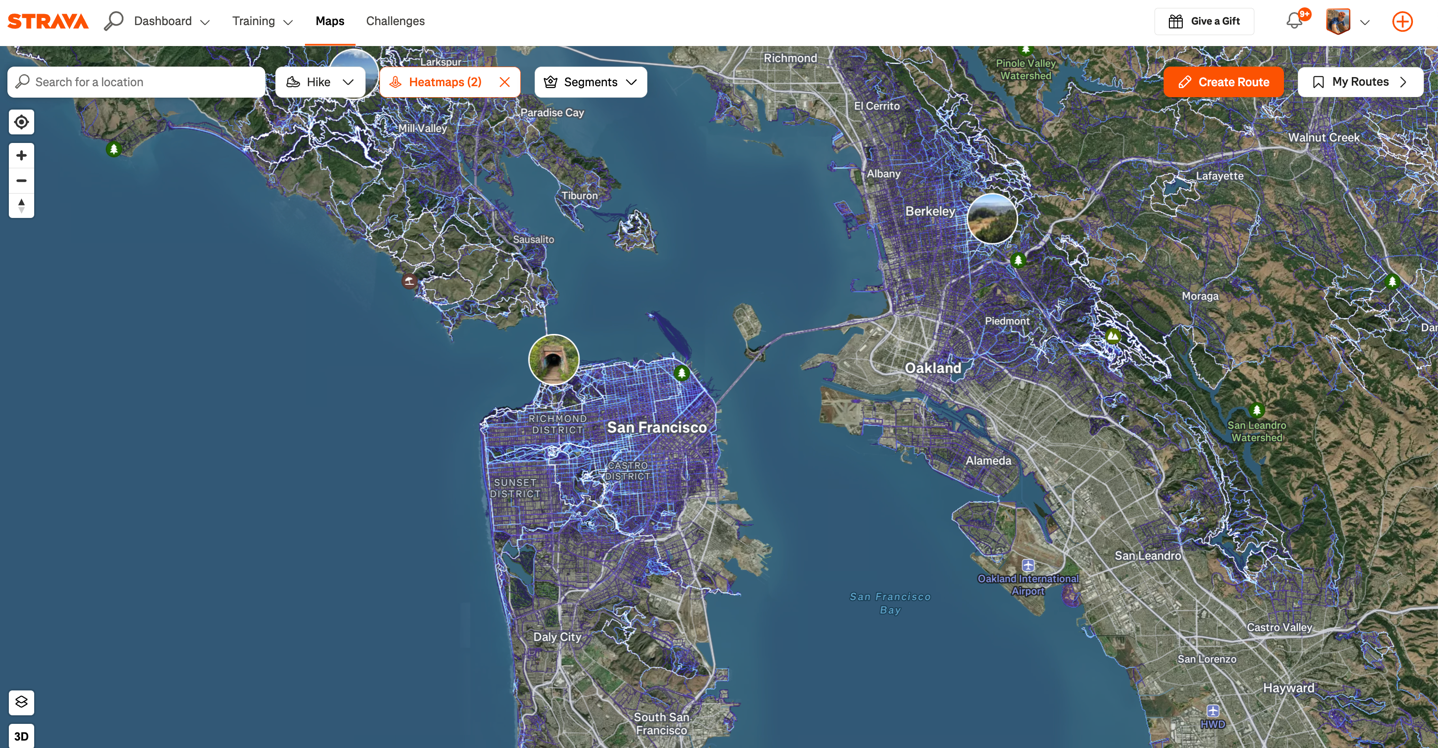
We’ll start here, because this is honestly the most clear-cut of the two (well, I’d argue both are clear-cut, but this is the one Strava is going to quickly lose).
The case essentially has two chief complaints, one focused on the Strava Segments piece, and the other focused on heatmaps and popularity routing. This second piece has one primary patent that Strava is saying Garmin violated (patent 9297651), with an ancillary patent 9778053. Both of these cover what Strava titles “Generating user preference activity maps”. In a nutshell, this means generating a map that shows where other users work out, based on other users’ ride/run/etc data. Here’s the exact wording, for funsies:
“Generating user preference activity maps is disclosed, including: collecting a plurality of user activities recorded by a plurality of GPS recording devices; determining a user preference map based at least in part on analyzing the plurality of user activities to aggregate user activity data associated with a base map; and determining one or more suggested routes between a user input first endpoint and a user input second endpoint based at least in part on the user preference map.”
The ’651 patent (the main one) was applied for on December 15th, 2014, and then issued in 2016. That first date will be super important in a second. The secondary patent was applied for in 2016, and issued in 2017.
In the filings/case, Strava says that Garmin has violated this patent by not only copying it, but putting it in devices, like their watches and bike computers.
“87. Defendants have directly infringed and continue to directly infringe one or more
claims of the ’651 Patent, including at least Claims 1, 2, 8, 9, 11, 18, and 23 (the “Asserted ’651
Claims”), by making, using, offering to sell, selling, and importing products and services that
practice the patented technology in the United States, without license or authority, including
Garmin Connect and Garmin devices—such as Edge cycling computers and Forerunner, Fenix,
and Epix watches—that implement Trendline/Popularity routing, heatmaps, Courses, and related
features (the “’651 Accused Instrumentalities”).”
And, this is all true. All of this exists today, and has for…well…a decade. And thus, in late June 2025, culminating this past July 25th, 2025, Strava said they formally notified Garmin of this issue (again, these dates are important, for different reasons, in a moment):
“94. Defendants’ infringement has been and continues to be willful. Despite their
knowledge of the ’651 Patent and their infringement since at least July 25, 2025, Defendants have
intentionally or recklessly continued their infringing acts, making this an exceptional case and
warranting enhanced damages and reasonable attorneys’ fees under 35 U.S.C. §§ 284–285.”
Except, here’s the really fun part that revisionist history (a popular thing these days), tends to forget: Garmin actually had heatmaps first. And popularity routing first. In fact, they had it more than a year and a half before Strava filed their patent for it.
Garmin first started putting heatmaps in Garmin Connect back in early 2013. You can see images here from Garmin’s announcement. These were initially in US cities, before being expanded outwards. Heck, the New York Times even had a heat map site from June 2013 (it still works!!!). The Garmin site even had layers, too, for the heat map:

Similarly, in June 2013, I wrote about a 3rd party site that looked at the underlying Strava activity data to generate heatmaps and routes (I also found references back to October 2012 there, too). That 3rd party developer was not Strava, but simply using the then widely available underlying Strava activity data to create heat maps (since Strava heatmaps didn’t exist then). Here’s the high-level view:
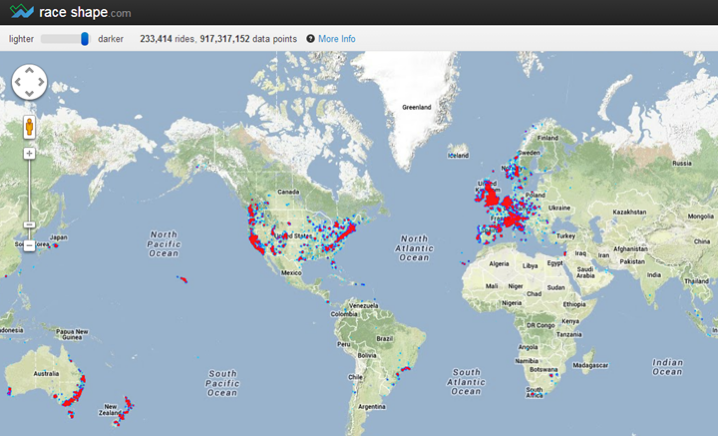
A further look at the street view on RaceShape. Again, these screenshots are from June 2013 (18 months before Strava ever filed its initial patent in 2014).
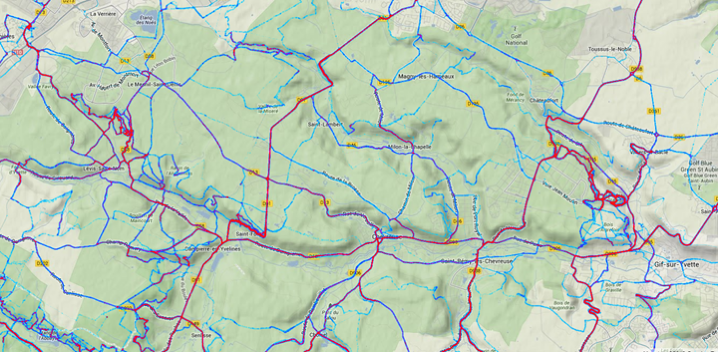
But likewise, there are plenty of other examples at the time. Heatmaps and the generation of routes across them were simply were not a Strava invention, nor were they new. And this ignores the industry heavyweights at the time of MapMyRide, MapMyRun, etc…
Strava’s first heatmaps wouldn’t actually come until September 2013, when they then launched Personal Heatmaps, showing your own heatmaps for your own activities.
Point being, by the time Strava got around to implementing it, let alone filing a patent for it, heat maps was old news. The fact that they got a patent for it (and looking at the specifics of the patent, there’s nothing special there) is a testament to how messy software patents have been over the years. And hardware, too, for that matter. When the US Patent and Trademark Office grants a patent, it does so based on the application presented to it, combined with an examiner trying to find examples of prior art that would invalidate it. Or, the concept of an idea being so obvious that it can’t be patented. In this case, the prior art is frankly quite broad, and it’s surprising they got the patent at all.
Garmin’s lawyers will easily argue this patent shouldn’t have been granted and get it invalidated. That’s the exact same thing we saw when Wahoo tried to sue Zwift a few years ago, and the judge had one look at Wahoo’s patents and basically said ‘Dude, these probably never should have been granted’. Wahoo quickly dropped the case after that initial review, before the patents actually got nullified.
There’s no way this patent should ever have been granted. But we’ll circle back to why Strava is upset about this specific item, a decade later, in a second.
The Strava Segments Patent:
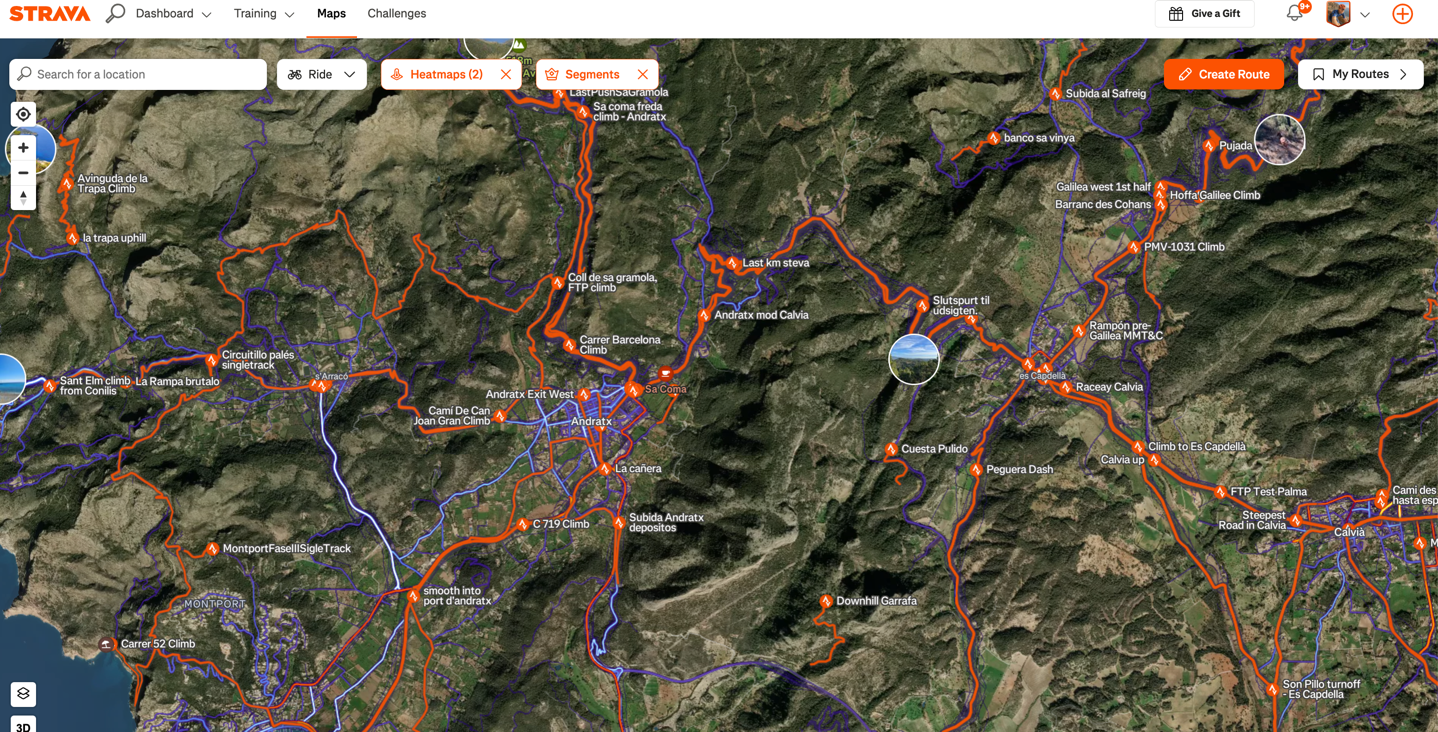
Next, there’s the Strava Segments patent. This is frankly the most bizarre of the ones out there. Mainly because, like the first one, Garmin and Strava have been doing this together for a decade. The two companies have worked incredibly closely, and Garmin has been Strava’s closest and best partner for a decade. While Garmin had often considered acquiring Strava back then, they determined it didn’t serve a purpose. Garmin got everything they wanted out of the relationship (including priority handling), without the cost/hassle of an acquisition. After all, and especially back then, Garmin users made up the majority of paying Strava subscribers. Therefore, it was in Strava’s best interest to keep Garmin and their users happy.
In any case, this patent basically covers the concept of a Strava Segment. The 9116922 patent was initially filed on March 31st, 2011, and granted years later on August 25th, 2015. Here’s the official patent definition of a segment, for funsies:
“Defining and matching segments is disclosed. In some embodiments, defining and matching segments includes receiving a user defined segment via a user interface input; and determining a matching effort (e.g., which can include a set of Geographic Positioning System (GPS) data) to the segment using a processor. In some embodiments, the data associated with the effort includes one or more of the following: heart rate, speed, time, and power. In some embodiments, defining and matching segments further includes storing data associated with the matching effort with the segment. In some embodiments, the user defined segment is based at least in part in uploaded GPS data. In some embodiments, the user defined segment is based at least in part on selected points on a map application.”
Now, what’s notable here is that Strava existed (with users creating segments) from 2009, and thus, it’s a bit strange that Strava had a two-year gap here before they got around to filing a patent on it. This is well beyond the typical 1-year grace period that the US PTO would allow for delays in filing a patent after public disclosure.
Nonetheless, Strava says that in 2014, Garmin copied Strava Segments and put it into their platform. I don’t think there’s any disagreement there, to be honest. Nor can I think of examples of a Segment-like functionality that existed prior to Strava. Of course, the concept of racing up a mountain along a given route for a time split, definitely existed prior to Strava (example, the KOM jersey in the Tour de France). But patents aren’t all about ideas, they are about technical implementation. In this case that includes things like gates to enter the segment, how those GPS points are treated, etc…
So, playing history for a brief second here. Garmin introduced Garmin Segments on Garmin Connect alongside the Edge 1000 in June 2014. They then expanded that to other Garmin devices over the remainder of the year. This included leaderboard functionality and such on Garmin Connect. Here’s a screenshot from 2014 of Garmin Connect’s web interface for that:
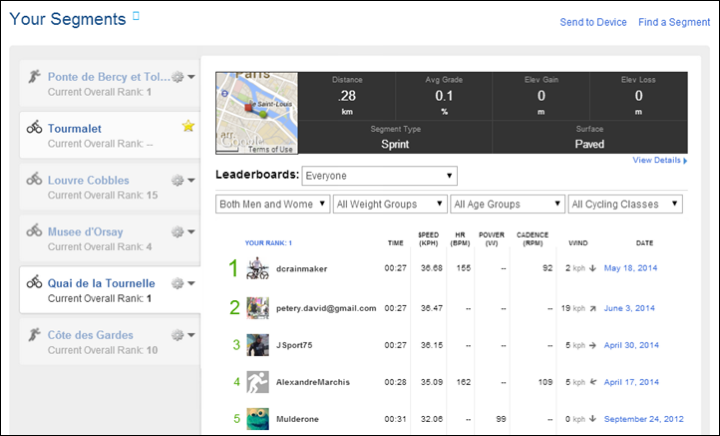
And then the same on the Edge 1000, using a Garmin Segment back in June 2014:
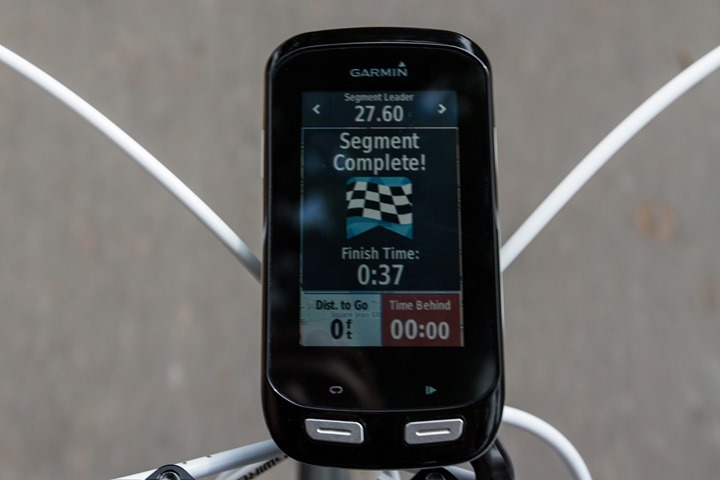
But ultimately, nobody really cared. Everyone wanted Strava Segments.
Strava notes this in their filing, saying:
“On information and belief, Garmin has long sought to leverage its hardware footprint to build its own social and competitive fitness experiences, but those efforts have failed to match Strava’s adoption, engagement, or network effects. Given the low popularity of Garmin’s internally-built features, Garmin sought to collaborate with Strava to directly integrate Strava’s segments into Garmin’s devices.”
That’s all true. So, on April 8th, 2015, they signed an agreement to implement Strava Live Segments on devices instead:
“To provide Garmin users with segment features that met Strava’s quality bar, the parties cooperated and entered into the MCA on April 8, 2015. The MCA—signed by Garmin, Ltd. and Strava—permitted Garmin to use defined “Strava Segments” solely to implement the user experience set forth in Exhibit A to that agreement.”
Though this almost certainly was in the works before that, given it would be less than 90 days later that Garmin rolled out Strava Live Segments on devices, something definitely not possible in Garmin’s software development timeline history.
As noted, this went live on Garmin devices on July 7th, 2015, here on the Garmin Edge 520 on launch day:
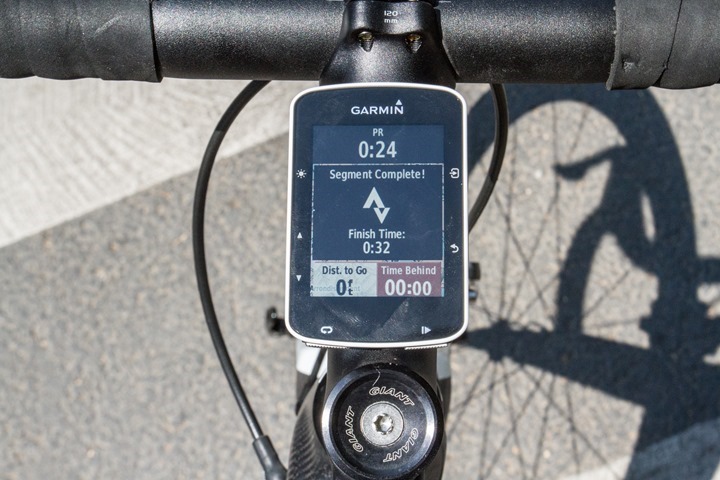
That was part of a ‘Master Cooperation Agreement’ the two companies signed. Interestingly, the lawsuit notes a specific provision of the agreement that requires that Garmin doesn’t display Strava Live Segments concurrently with Garmin Segments at the same time. Frankly, that’s probably for the best, otherwise things would be a hot mess. Nonetheless, this would become the basis of the Strava Live Segment feature rollout on numerous other manufacturer devices, such as Wahoo bike computers and many more. All of which required a premium Strava subscription to work.
In any event, the MCA also outlines a bunch of other things, with the lawsuit saying:
“The MCA includes strict restrictions and safeguards: Garmin receives a limited, revocable, non‑sublicensable license; may not adapt, reverse engineer, use, copy, modify, or distribute Strava Segments except as expressly licensed; and must comply with confidentiality and use‑of‑materials limits. The MCA also contains remedies and a carve‑out from limitations for breaches of these restrictions, along with fee‑shifting in specified circumstances. Strava performed under the MCA, including by delivering Strava Segments and integration materials, providing updates, and supporting Garmin’s implementation of the agreed user experience.”
Now, keep in mind, this is mostly just legal talk about legal things. However, the next paragraph is more interesting:
“Despite the MCA’s clear limits, Garmin expanded well beyond that agreement’s scope. Garmin built, branded, and widely deployed Garmin‑branded segments outside the Strava‑built experience and to non‑Strava users; enabled segment competition and leaderboards across Garmin Connect (web and mobile) and on devices; and surfaced segment results independent of the Exhibit A constraints.”
Here, Strava is saying that Garmin was supposed to stop expanding Garmin Segments, and use Strava Segments instead. Again, casual reminder, this happened a decade ago, and now Strava has decided they’re upset about it. Strava seems to be implying the MCA limits Garmin’s ability to roll out their existing Garmin Segment feature to other devices.
Sadly, at this time the MCA hasn’t been uploaded to the case docket, though, perhaps Garmin’s lawyers will do so in their response. So we can’t see what it actually says. But I’d be reasonably surprised if Garmin agreed to killing their Garmin Segments feature. Garmin knew it wasn’t popular, but also saw it as an alternative for those that didn’t have a paid Strava Subscription, even if they weren’t “competing” in the Strava ecosystem.
Either way, I don’t think anyone would argue Garmin Segments has been meaningfully successful since then. Nor has anything really changed since 2015. Garmin offers Segment capability on all their devices, regardless of whether it’s Strava Segments or Garmin Segments. And Strava hasn’t cared for…checks notes again…a decade.
Further, I went back to Strava to clarify if they had a statement about this, and they said:
“Garmin received limited permission from Strava to implement Strava Segments on their devices; however, they leveraged this access to carefully study those features, painstakingly copy them, and then release them as Garmin features. Garmin rejected Strava’s repeated attempts to address the infringement informally, forcing Strava to take a stand on the matter and file suit to protect its patented inventions.”
I then replied, asking why after 10 years, they would file suit, and they replied:
“While we can’t provide additional comment on the suit at this time, we encourage you to read the complaint, which provides a full background of Garmin’s actions and infringement.
Regarding timing, we reached out to Garmin repeatedly over a period of several months to resolve this amicably, and were rejected. Garmin has been increasingly aggressive to its partners lately (perhaps due to competitive pressure) and Strava is standing up for the hard work our teams have put into building unique features.”
I’m legit impressed Strava wrote “increasingly aggressive to its partners”. Like, after last year? That takes balls of steel.
Why is Strava Actually Suing?

Ahh yes, and this gets to the heart of the matter. First off, let’s see what Strava says in their filings:
“Strava provided written notice of infringement and breach at least by June 30, 2025, and again in July 2025, yet Garmin has continued its conduct, causing ongoing harm to Strava. Additionally, Garmin was on notice, as a result of its collaboration with Strava and the 2015 MCA, that at least Strava’s segment technology was protected by Strava’s intellectual property rights. Nevertheless, Garmin continued to use Strava’s technology in ways that Strava has never authorized or licensed.”
So, starting in June 2025, Strava officially notified Garmin that they were upset about the Strava Segments, and then again on July 25th, 2025. But why those dates?
Ahh, see, this gets to turbulence behind the scenes. We have to rewind the Strava API fiasco of Fall 2024. Yes, that one. The one that required API partner (and loose competitor) TrailForks to delete some 60 million activities from their platform.
While Strava held the rest of the industry somewhat hostage, Garmin was mostly excluded from that wrath. Again, Garmin is the heavyweight here and makes up the majority of paid Strava user data sources. However, that doesn’t mean Garmin was happy about it. In fact, they were quite upset about a few key things.
First, they weren’t at all happy about the AI pieces. Specifically, they weren’t happy about Strava using Garmin user data for AI training (data from Garmin users that uploaded to Strava), without any real control over that from a user perspective. All while Strava was basically prohibiting their downstream API partners from doing any AI training. Garmin saw this as a bit of a wonky double-standard.
Further, Strava was starting to require that all 3rd party apps more clearly label the data as coming from Strava, when it showed on 3rd party websites via the Strava API. Again, Garmin saw this as a wonky double-standard, because Strava didn’t do this for data coming from Garmin Connect via the API.
This was called ‘attribution’, and over the course of the spring, Garmin started working on a new Garmin Connect API policy around attribution. They presented this to bigger partners during that timeframe for feedback, and ultimately announced it in July 2025 under ‘API Brand Guidelines’.
Here are some examples from that document:
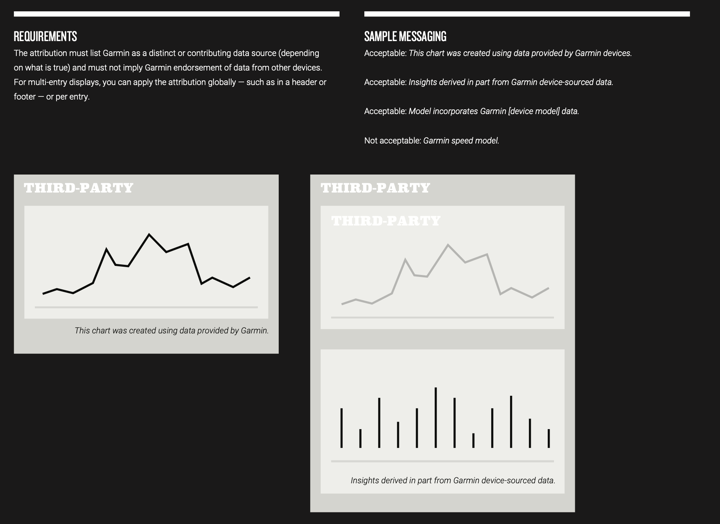
This isn’t really any different than what you’d see on Google Maps or other platforms, where the underlying data source is shown.

Garmin noted at the time that developers basically had to have this done by the end of 2025, but that they were pretty flexible on making that happen or assisting on timelines as necessary (a pretty big departure from the Strava mandate of “you have 30 days during the holidays” of 2024 fiasco). Either way, Strava was displeased about this, and had pushed back the most about it. For other developers, it was almost entirely a ‘shrug, sure’ type thing.
So then, why were heat maps and route creation pulled into it? Well, I suspect that Garmin’s May 2025 announcement of their Trails+ feature might play into that. That’s part of Garmin’s paid Garmin Connect+, and it uses various filtering operations to find routes near you.
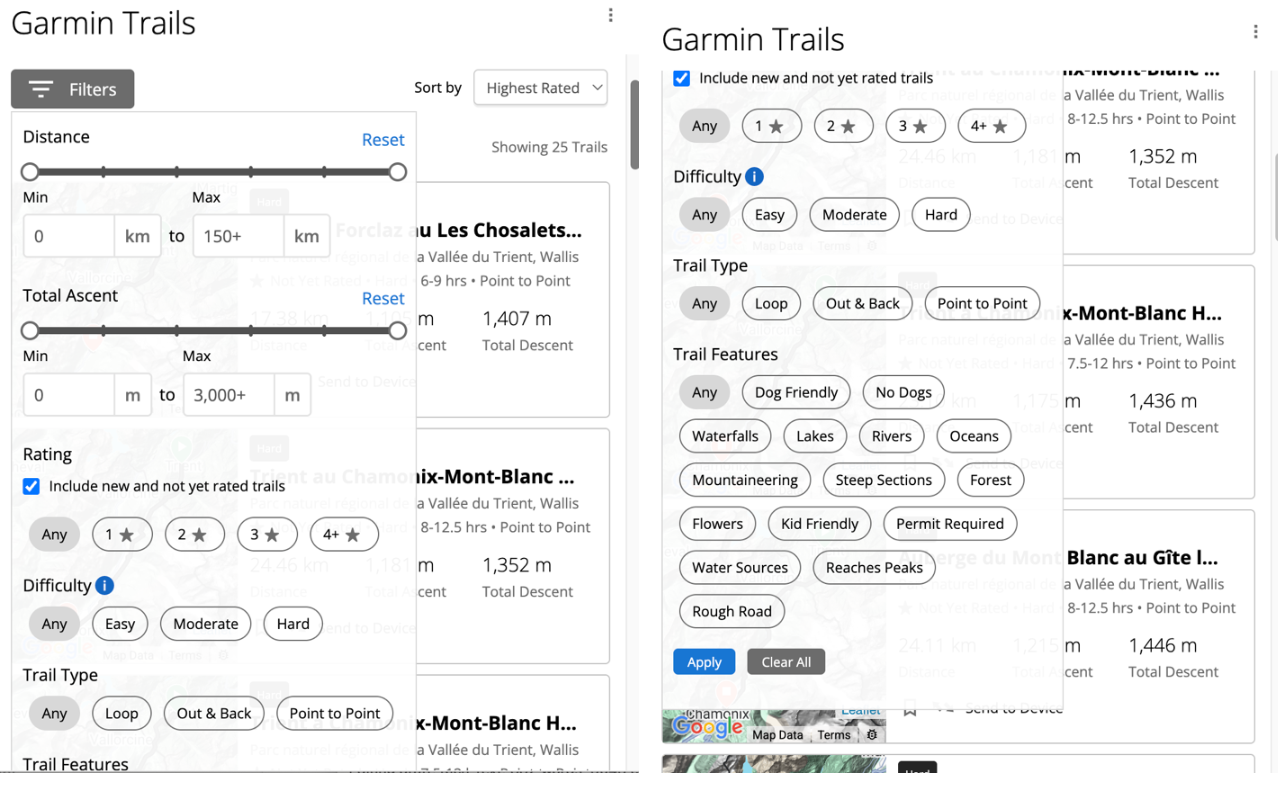
Of course, this feature has literally nothing to do with the patent, but that’s neither here nor there.
Instead, Strava sees this as Garmin starting to encroach on their subscription-based turf, and thus cutting into Strava revenues.
To that end, Strava goes on to say:
“Defendants’ infringement has been and continues to be willful. Despite their knowledge of the ’053 Patent and their infringement since at least July 25, 2025, Defendants have intentionally or recklessly continued their infringing acts, making this an exceptional case and warranting enhanced damages and reasonable attorneys’ fees under 35 U.S.C. §§ 284–285.”
And then from here, they’re asking the court to prohibit Garmin from selling any devices with Segment or heat map features (that’s basically all fitness devices):
“Strava is therefore entitled to a permanent injunction prohibiting Defendants from making, using, offering to sell, selling, or importing the accused implementations (and any colorable variations) of the patented technology.”
“Monetary relief alone is inadequate. Garmin’s continued infringement of the ’922 Patent causes irreparable harm to Strava, including loss of network effects, erosion of platform differentiation and goodwill, and brand loyalty that cannot be fully measured or compensated in money. There is a causal nexus between the accused segment-identification, matching, and ranking and consumer demand for Garmin’s devices and services. Strava is therefore entitled to a permanent injunction prohibiting Garmin from making, using, offering to sell, selling, or importing the accused implementations (and any colorable variations) of the patented technology, and Strava has no adequate remedy at law; the balance of hardships and the public interest favor injunctive relief.”
Got all that? Good.
Update From Strava:
(This update was added at ~12PM US Eastern time on Oct 2nd)
Strava has gone to Reddit to publish an update from their perspective on why they are suing Garmin, which in short boils down to them being upset about the new data source/branding requirements.
Here’s their statement:
“Hi r/Strava, it’s Matt Salazar here – Strava’s Chief Product Officer. As you have seen, we’ve recently taken some action against Garmin. I wanted to post on here to share some background on why we did this and the situation with Garmin.
On July 1st, Garmin announced new developer guidelines for all of its API partners, including Strava, that required the Garmin logo to be present on every single activity post, screen, graph, image, sharing card etc. We have until November 1st to comply, and if not, Garmin has threatened to cut off access to their API, stopping all Garmin activities from being uploaded to Strava.
We are actively trying to prevent this from happening for two reasons:
- 1. We consider this blatant advertising. These new guidelines actively degrade your user experience on Strava (and the other 150M+ athletes). We already provide attribution for every data partner, but Garmin wants to use Strava and every other partner as an advertising platform – they told us they care more about their marketing than your user experience. Garmin doesn’t even provide data attribution for 3rd party devices (such as heart-rate monitors or power meters) on the Garmin Connect app.
- 2. We consider this to be YOUR data. If you recorded an activity on your watch, we think that is your data. We believe you should be able to freely transfer or upload that data without requiring logos to be displayed alongside it or have that data be used as an advertisement to sell more watches.
Unfortunately we could not justify to our users complying with the new guidelines. As such, we have tried to resolve this situation with Garmin over the course of the past five months, including proposing additional attribution across the platform in a less intrusive way, but to no avail.
We know we have a lot of Garmin users on Strava as well as r/Strava and so wanted to be clear with everyone as to the current situation and what we’re trying to do to resolve it.”
Hmm, the only challenge here is that they don’t require that logo. You can read them right yourself here. Or in the screenshot below.
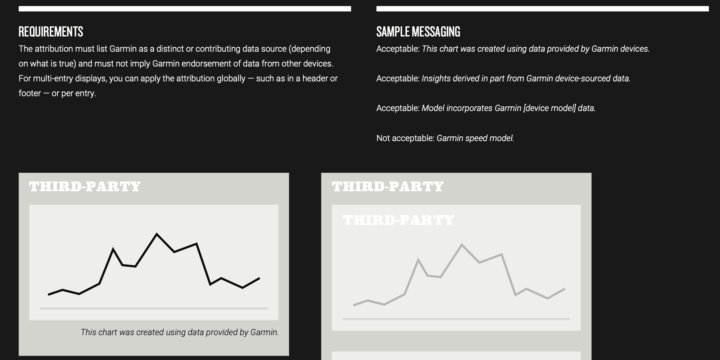
As seen here and throughout the document, this does not require the Garmin logo. It simply requires that the platform note the source of the data, just like mapping and other providers do. In fact, Strava’s own mapping providers already require this.
The second piece that’s not quite logical is their ‘it’s your data’ argument. Since that runs entirely counter to the entire API fiasco of last year. Strava literally booted companies and your data off their respective platforms for that.
What Happens Next?

Obviously, Strava is asking the court (and thereby Garmin) to stop anything to do with segments or heatmaps, and to take all device sales off the market.
So, my first question to both Strava and Garmin was “What does this mean to users”? Will users’ connections break, their features break, sync of activities, routes, and so on? Surprisingly, Strava replied pretty quickly (kudos there), saying:
“Our lawsuit is between two companies; we do not intend to take any actions that would disrupt the ability of Garmin users to sync their data with Strava and hope Garmin values our shared users in the same way.” – Strava spokesperson
So it’s Strava’s hope that Garmin won’t retaliate. That’s probably a fair bet, since Garmin rarely likes to rock the boat in these types of scenarios. Instead, they tend to just win (virtually every time) in court, quietly, out of public view.
To prove that point, here’s Garmin’s official comment on the matter:
“We don’t have anything additional to share as Garmin generally does not comment on pending litigation.” – Garmin spokesperson
So what does Strava actually want? Since their new CEO was appointed a year ago, they’ve gone on the offensive when it comes to industry partners. While I think he’s done some good user-facing feature things, there’s also been a lot of not-so-awesome policy changes. And of course, looming over all of that is the upcoming Strava IPO. Perhaps this is to drum up interest there.
I can’t help but sit here and wonder how poking the bear accomplishes that. Sure, Strava got away with roiling their API partners a year ago, but this time, they’re trying to attack their most important partner, Garmin. And do so over something pretty trivial. I note ‘most important partner’, because while one might see Apple as the most important partner for Strava, the two companies have never been particularly close by Strava standards. Strava has made advances over the last year or so to change that, and perhaps they think that by suing Garmin it’ll somehow earn them credits at the Apple Store. Who knows.
But what I can tell you is that if I were someone on Wall Street looking at this situation, I’d be doing a solid double-take of Strava’s leadership right now. You’ve just poked a bear that virtually never loses patent disputes, and done so by picking a patent that’s likely to get nullified, while concurrently being upset about something that happened 10 years ago. All while running the risk of Garmin simply saying “No problem, let’s turn off the API from Garmin to Strava”. Instantly, you’re hemorrhaging paid Strava users. For what reason? Just because you don’t want to put tiny source/attribution text on a display page somewhere?
And that’s before we remember that Strava appears to only hold 26 patents. Garmin? Likely thousands. It’s almost guaranteed that Strava has run afoul of some existing patent Garmin holds, that Garmin could countersue for. Over the last 12-14 years, Garmin has largely taken a “don’t sue anyone” approach to its patents. But that could change here.
This just seems like an incredibly bizarre move that’s almost certain to backfire.
Either way, I’m sure this lawsuit will provide us with all sorts of good document fodder for the next few months (or years), so at least we get that.
With that, thanks for reading!
FOUND THIS POST USEFUL? SUPPORT THE SITE!
Hopefully, you found this post useful. The website is really a labor of love, so please consider becoming a DC RAINMAKER Supporter. This gets you an ad-free experience, and access to our (mostly) bi-monthly behind-the-scenes video series of “Shed Talkin’”.
Support DCRainMaker - Shop on Amazon
Otherwise, perhaps consider using the below link if shopping on Amazon. As an Amazon Associate, I earn from qualifying purchases. It doesn’t cost you anything extra, but your purchases help support this website a lot. It could simply be buying toilet paper, or this pizza oven we use and love.






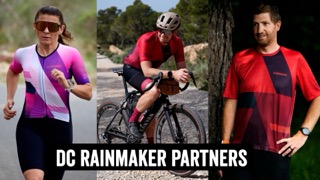
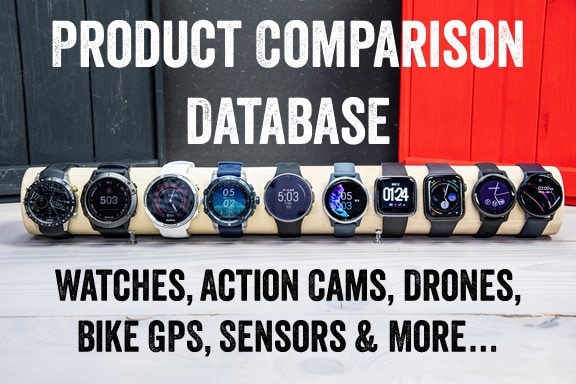
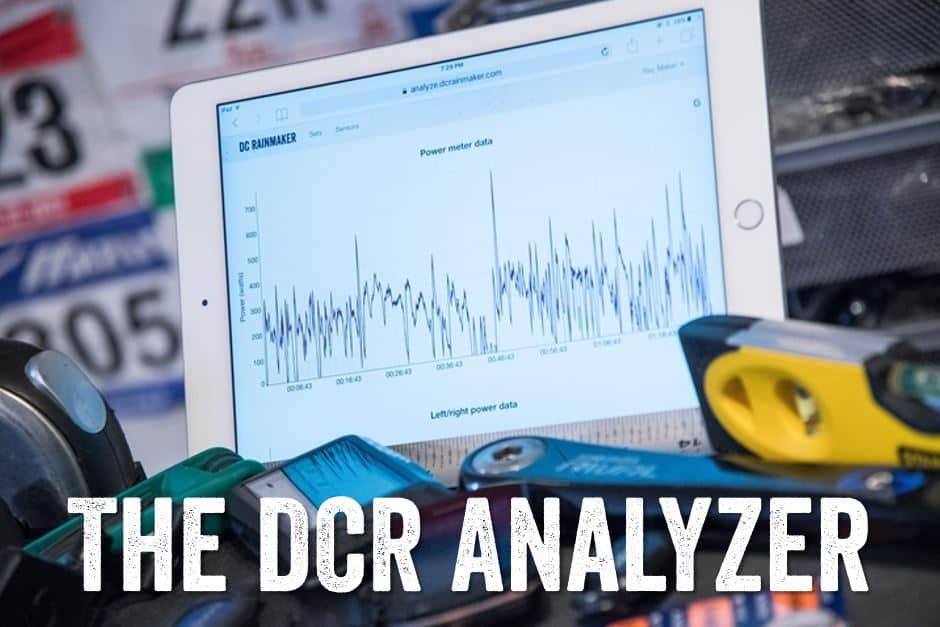



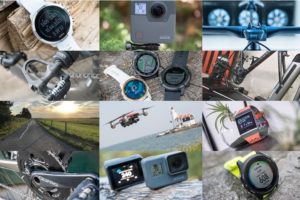
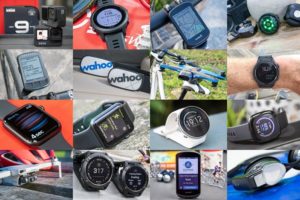



FYI about reading patents: The key to patent infringement isn’t what’s disclosed, it’s what is claimed (in the context of what is disclosed). In order to analyze alleged patent infringement, you have to at some point focus on the claims at the end of the patent, not just the disclosures.
Indeed. From a claims standpoint, the heat maps one is fairly broad/basic, and basically just describes how heat maps worked for nearly two years before Strava came along. Again, how on earth they got this approved is beyond me. Claims are here: link to patents.justia.com
The Segments one is more specific (and I don’t really have any issues with that per se, setting aside the fact that they filed it two years after they went public with the feature).
Been a lot in the gaming news recently about Nintendo getting patents for game mechanics that many other games have already used.
Seems the patent people need proper specialists involved when granting patents.
Ditto what Alan said… the only thing that matters in patents is claims. If you look at the Heatmap patent, there’s 3 independent claims: 1, 13, and 23, but those are just variations on system, method, and product. So just looking at 1, the key phrase is ” determine one or more suggested routes between a user input first endpoint and a user input second endpoint based at least in part on the user preference map”. The patent is not about displaying heatmaps, it’s about auto-creating routes based on heatmaps. The June 2013 article you gave for Race Shape does not appear to include automatic route creation, but perhaps there are other examples that pre-date the patent.
It’s all fun to analyze claims and patents, but in the end this suit is just a negotiation technique as outlined by the reddit post pasted below.
Wouldn’t any Mapquest/Google Maps/Yahoo Maps/Garmin Nuvi route to home/address/gpscoordinate on the fly suffice?
Only if it used a “user preference map”, i.e. a heatmap, to to determine the route. For cars, using a heatmap to route might actually be the wrong approach, because it would route you on the busiest roads…
Oh hey, look. Someone who knows patent prosecution. Kudos.
The heat maps claims requires analyzing everyone’s activity data based on “an order associated with a plurality of GPS recording device types.” According to the patent, routes recorded on devices such as a Garmin are more accurate than routes recorded on devices such as a smartphone. Presumably, Strava when generating the heat map first analyzes routes recorded on say Garmins before analyzing routes recorded on say iPhones. Strava tried to get a claim without that requirement, but it was rejected. Arguably, Garmin’s Connect app doesn’t do that “ordering” as from what I understand the Garmin Connect app collects only from Garmin devices. The point is that the patent might not be as broad as Strava would like.
Time to ditch Strava? Feel that this is yet another example of an ill run business and only possible outcome is impacting its user base. The social aspect is not that important to me personally. I for instance only kept Strava around to learn about new routes friends would run. Nothing else.
To each their own.
I use Strava as a social network, and for route building. But, the route building pieces only because I’m always testing on multiple devices/platform, so I want something independent from any given manufacturer.
I love Strava as a product. But their management decisions? Less so.
This is where I am at, too. It is a bummer that every couple of months, Strava makes me question whether I should keep my subscription, because from purely a product standpoint, I really do enjoy Strava.
As a developer (trying to) use the Strava API and now, potentially, as a Garmin user, their poor decisions have a big impact on me personally. But ultimately, I will continue using (and paying for) Strava, all while hoping they stop picking fights with people and companies they would greatly benefit by continuing to cooperate with.
Route building – Plotaroute. Excellent, loads of maps and data.
To each their own, sure… but anybody who doesn’t like or at least appreciate the social aspect of Strava probably just doesn’t have any friends… 😂🤪
Something I’ve wondered about for awhile but was never relevant (until now!). Do you consider Strava important to the DCRainmaker brand? I imagine it helps with engagement for people to be able to see/follow your activities. I’ve wondered if you consider Strava a business tool at this point so you’d need to use it even if you didn’t like the platform overall.
Nah :: Just that I run for myself, Personally dont care for the social aspect of it as I dont run as a performative act.
Hopefully said tongue in cheek.
I use the basic Strava only for recording my routes. The “social aspect” of it is of zero interest to me. In fact my rides are private as the whole idea of “kudos” just seems stupid to me. I really don’t care if others like my ride.
I stopped paying for Strava after the API nonsense last year. This new drama makes me less likely to want to sign up again.
Someone who considers Strava social probably only has online friends
i see absolutely no reason to ditch strava. i love their route building and data logging over the years. but then again, i use another watch and i’m not in any garmin eco system nor do i care for their devices. strava has been an excellent product and this changes nothing. all subjective.
plenty of ways to build routes, but i like building them with heatmaps as a guide, whether global or personal. nothing out there comes even close.
Fascinating because I have found zero advantage to using the Strava route builder over Garmin Connect except in the context of a club where you want to share the routes to a wide variety of devices.
However that only works if everyone has paid Strava accounts. The vast majority of the club members use Garmin so we ended up publishing Garmin routes and GPX files exported from Garmin Connect for anyone that doesn’t use Garmin. That was the most universal option that didn’t require subscription fees to any apps.
Exactly where I stand.
Sharing route to family / friends via group was only feature making me pay Strava.
The ROI was already far from obvious.
Lack of innovative features, and the saga around API usage make me stopped the subscription.
If I resume paying Garmin Connect seems a much more compelling platform now.
I guess I’m a counter-example. All my Strava feeds are friends-only, and all my Strava ‘friends’ are real-life friends and relatives. We collectively use Strava to keep track of what others are doing, not doing, failing and accomplishing.
Hmm, I used Plotaroute for years, but I’m not renewing my subscription when it expires because after the change of ownership it simply doesn’t work as well. Features like “Snap Route to Map” (I may have that name wrong, but it’s something like that) now seem to be totally random, where previously it worked well. I wrote to them about that particular one over a year ago, renewed my subscription once since, and they still haven’t got it back to even close to a good as it used to be, so in the meantime I was forced to look at other options and I found one that is better, so that’s where my money will go next year.
This exactly. The things they do well, they do very well. Management on the other hand… needs a bit of a shake-up!
I also like using Plotaroute. I can’t see any issues with the “Snap Route to Map” feature.
PS, with regard to patent date, you need to look at whether the patent claims priority from a previous patent application. The previous application can be a provisional patent application or a continuing patent application. If so, the claims may be backdated to the previous application, if it was adequate. An inventor can therefore get patent protection for inventions that were practiced or publicly disclosed up to a year prior to the date of a previous provisional or continuing patent application. The “one year prior” applies only to the USA, not to any other country (that I’m aware of). I didn’t look to see if any of the Strava patents claim priority based on earlier patent applications.
Correct, in the case of Heat Maps, that claims priority from “61/914,859 entitled GENERATING ATHLETIC ACTIVITY HEAT MAPS filed Dec. 11, 2013”
Which, is still nearly a year after Garmin launched the feature (plus, whomever else).
This seems like a very poorly calculated move by the clueless Strava CEO. I really hope Garmin buries them. They certainly have a number of ways to make like very difficult for Strava.
So Strava is copying Apple and patenting other peoples ideas and suing them? Time to delete strava data and close the account.
Can you give any examples of when Apple patented another company’s idea and then sued them over it?
No he can’t.
Actually a few, but one concrete example: “Apple was found by a jury to have copied several of Samsung’s features, including a camera and folder organization functionality, and video transmission functionality for FaceTime, which were covered by two Samsung patents.”
Samsung has copied features from Apple too, naturally.
JW did Apple file patents for those “copied features”? I’m not asking if Apple has ever been sued for patent infringement, but specifically if they copied other peoples features and then patented them. Your examples are not that.
Re Apple:
link to engine.is
The most well known is the slide to unlock, but there have been others.
PPS, Strava claims a priority date of Dec. 11, 2013, based on provisional and continuing patent applications. If that date is upheld, then only prior art that existed as of Dec. 11, 2012, will matter to the case.
Yeah, there’s still plenty of 2012 prior art around cycling heat maps here, including via RunKeeper:
link to gis.stackexchange.com
Obviously, one has to get into the nuances of the claims, but these heavily muddy the waters for Strava’s claim to own heat maps.
Per my above comment, the patent only claims *routing* based on heatmaps, not display of heatmaps. This stackexchange link only seems to be related to display of heatmaps.
Grace periods only apply to prior art disclosures by the applicant and are calculated in reference to the filing date of the application in question. Priority dates only establish the claim date, meaning any non-applicant prior art that existed before the claim date (i.e., the allegedly valid priority date of December 11, 2013) can be applied against Strava’s patent.
Strava is nothing without Garmin
+1 – was thinking the same thing.
While that is kind of true, I can see myself using a Garmin competitor in the future, especially if their prices continue to rise and they persist with Garmin Connect Plus.
What i can’t imagine is using a Strava competitor for the social aspect, I might quit with the subscription though.
This simply is not true. Many of my friends are using the Strava app on their phones, and not their watches or bike computers. They simply don’t care or they have other expenses they use their money for. I mean, the fastest cyclist on my friend list frequently rides with an empty Garmin mount and his phone in his jersey pocket running the Strava app. He just can’t be bothered to find, and then charge, his Edge computer. Lots of runners I know still use the Nike app!
There’s no question Strava would quickly fall apart without inbound Garmin data.
Historically speaking (and from various conversations still true), Garmin users make up the largest source of paying Strava members.
Which isn’t to say there arent lots of non-Garmin members, obviosuly, there are many tens of millions. But those members aren’t funding Strava’s bottom line in any meaningful way, aside from seeing various ads (challenges/etc…).
I have been trying to figure out what the breakdown of dedicated fitness device uploads vs using the strava app to record. I came up empty. The only relevant thing I found was a press release from 2024 by Strava claiming “nearly three out of four athletes hit Record in the app to log their activities” — meaning they used the app on their smart phone.
They did not say 3/4 actual uploads come from the app or 3/4 paid subscribers use the strava app. I would bet that only the most casual users use the Strava app and most of the activity uploads come from garmin devices and apple watch but I have not been able to find a source.
This is a fun technical side discussion/rabbit hole.
A couple of small points:
1. It is not “clear” or “obvious” that Garmin Connect is getting all the information about/from its own sensors just from the FIT files. They possibly _could_ but in practice there might be some proprietary Garmin data exchange happening.
2. Also note that this all via the open BLE/ANT protocol. It would be easy for anybody to build a device that transmits over these open standard protocols and have it identify itself as a Polar/Garmin/etc. device even it is not. So Garmin actually does not _really _know where the data is coming from.
But the bigger point is that it is not directly germane to the attribution issue at hand:
Garmin wants attribution for data collected from its own custom (but quite transparent) API, NOT for anything from standard/completely open standards for data sharing
Oops, this was intended as a follow-up to the exchange between Will and Brian about showing sensor/device information in Garmin Connect here:
link to dcrainmaker.com
Hi SG, both Bluetooth and ANT require hardware certifications, and part of that registration process includes creation of a unique company ID. Yes, you could technically build an unregistered device that spoofs, but the (much) easier way to accomplish the same goal would be to simply create a FIT file containing spoofed data and upload it manually.
I’d say the odds of Strava winning this one is fairly slim. Likely, many patents in their portfolio get nullified, including heatmaps. This isn’t going to end well for Strava.
Great post. You’ve got two advantages here, Ray:
1 – You’ve been in the industry long enough to have experienced all this stuff
2 – You clearly haven’t had enough free press beer for it to affect your memory
My money is on the blue corner
What greediness makes with people. They could both keep win win status quo if not for Strava
Garmin without Strava? I think you’ll find the economic reality of that is flipped. Garmin is a publicly held conglomerate with multiple profitable business units, including private and commercial aviation and maritime. Strava’s original business model was to build heatmaps using crowdsourced data to sell to cities and counties to help improve pedestrian and bicycle safety – this failed to take hold, and they’ve had multiple pivots and leadership changes since.
(Sorry, I replied to the wrong comment; not directed at Kanat).
Enshtification comes to Strava. This is a terrible move. Cancelled the paid family membership.
Boo hoo
Garmin has been losing public goodwill lately, in comes Strava to the rescue…
seems to me the opposite is true
I agree
I want to like and support Strava but it is getting harder and harder. Same with Wahoo. I’ve been with both of them for 10+ years. I understand it is a difficult market but their actions over the last several years have been difficult to understand and support.
I dropped Strava long ago because of obnoxious moves like this especially after what they did to their api partners. I have less than zero need for my workout app to be a social network which is what they are really focused on becoming while monetizing (i.e. selling) our data.
To me this is a case of Strava looking at their business model and looking and what they are charging people for under their subscription paywall and then getting angry that “competitors” are not charging for the same feature. Pretty sure personal heatmaps and anything to do with segments are paywalled at Strava and not on Garmin Connect. I love strava and pay for the premium version mostly because I’ve enjoyed the platform for 12+ years, but this is a bizarre take. I’ll be honest, I had no clue there was a segments feature within Garmin, especially seeing the popularity of real-time pacing/challenge feature for Strava live segments on Garmin units. The issue is with Strava being beholden to the SaaS business model and trying to go after a company whose primary model is selling hardware that comes with supporting software. I don’t see any way this ends well for Strava. You’re going to burn goodwill with your fanbase, and the legal money you spend on bringing something forward is going to very quickly get thrown out of court and you’re going to turn a partner in Garmin into an enemy.
> To me this is a case of Strava looking at their business model and looking and what they are charging people for under their subscription paywall and then getting angry that “competitors” are not charging for the same feature. Pretty sure personal heatmaps and anything to do with segments are paywalled at Strava and not on Garmin Connect. I love strava and pay for the premium version mostly because I’ve enjoyed the platform for 12+ years, but this is a bizarre take
Yeah I think this is hugely ironic because most runners I know literally never open Connect, and use Strava for everything. For this kind of Strava user, there is literally nothing Garmin could ever do to harm Strava’s business (except turn off activity syncing from Garmin to Strava.)
Going beyond that, I think that everything that Garmin does that’s similar to Strava almost always has a worse user experience on the Garmin side. I could go on for days about all the big and small user experience fails on the Garmin side. The only reason I ever open Connect is because there’s certain data in the Connect app/website I can’t get on other platforms (even though they consume activity data from Connect).
I can’t speak to any of the legal aspects, but from a practical/realistic POV, all of this sounds like a joke to me. Basically Strava is mad that Garmin does a lot of the same things that Strava does, except worse, and nobody’s using the Garmin things.
Strava may as well sue Garmin for having a bare bones social activity feed in Connect.
I guess we all know now what’s *really* going on, so I take back everything I said.
This is just a tit-for-tat legal manoeuvre which really has nothing to do with the features in question.
This is an extortion lawsuit. Strava wants cash, Garmin at 20 times their size could fork over a reasonable chunk to just settle and make it go away.
Somehow, I don’t see Garmin caving. But that’s just my opinion, and I could be wrong.
*Garmin attorneys furiously reading this post to help with court filing research*
They will also be on the look out for potential expert witnesses if and when this gets closer to trial…
I’m relatively certain that Garmin’s lawyers are currently going through Strava’s functionality to see where Garmin’s patents have been infringed upon and will likely countersue, rendering a lot of Strava’s so-called IP void and lessening the value of the company in its IPO. Stupid, really. I think Garmin has somewhere between 60-70% of the device market (I could be wrong there), it would seem that as someone else said, Strava needs Garmin much more than Garmin needs Strava. Personally, I really only use Strava for its social networking… IMO, there are much better route-building apps (RWGPS, to name one). I think Strava may be cutting off its nose to spite its face. I’m surprised its general counsel didn’t emphatically ask “Are we sure we really want to do this?” But then, the job market is tight these days…
This was my thought as well. This seems pretty dubious on most levels. I just forwarded this to a lawyer friend who did a quick read, and his comment was “I wouldn’t want to be on the receiving end of Garmin’s response”.
This is like “bite the hand that feeds you” stupidity.
I imagine they didn’t need this lawsuit to inspire research into whether Strava was violating any of their parents. Just because they don’t have a history of suing other companies doesn’t mean they don’t keep track, precisely for situations like this even partnership negotiations.
Maybe that’s what they want prior to the IPO. Consider deciding to buy Strava stocks and then stopping and thinking “well what if most of their offering is based on Garmin’s patents that they just haven’t been sued over yet?” So sue Garmin pre-emptily for some of your own trivial patents and in return settle for a mutual patent suit freeze. Now your IPO is on a firmer footing
You have to wonder whether this is anything to do with Strava Metro?
Strava sell the heatmap data to cities and local governments for street planning etc.
Could be a decent chunk of change, and affect their IPO?
Honestly didn’t realize there was an upcoming Strava IPO, now that you say that it explains so much about their recent decisions.
Strava does not sell any devices. Without the data it collects from Garmin, Suunto, Polar, Coros, Wahoo, Hammerhead, etc., Strava is nothing. They do a good job analyzing the data synchronized from other devices, but if it weren’t for them, Strava would not exist.
On the other hand, the easiest solution would be for Garmin to buy Strava.
I’m sincerely hoping Garmin doesn’t buy Strava as I’d hate to think what the long term impact of this would be for non-Garmin users.
In other circumstances, I’d be supporting Garmin here BUT the pricing of their watches and head units has become laughable, and I’ll be taking a much closer look at the opposition when my Edge 530 and my Edge Explore 2 batteries finally expire. (My Forerunner has already expired and replaced by an Amazfit watch)
C’est ce qu’ils ont espéré pendant des années 🙄
I agree, neither of these companies do anything to inspire my loyalty as a customer, and it keeps diminishing year over year. Client satisfaction is almost a side effect and readily ignored in favour of increased profitability in the next quarter.
> I’m sincerely hoping Garmin doesn’t buy Strava as I’d hate to think what the long term impact of this would be for non-Garmin users.
Honestly, I also think the user experience of Strava would be much worse if Garmin bought them out.
Pretty much everything that Garmin and Strava both do, Garmin does worse (from a UX POV), including something as simple as allowing users to select gear (shoes) for a running activity.
Garmin also has a lot of features that sound great on paper, but fall flat in practice, often due to UX issues.
My personal opinion is that Garmin is not good at UX, and they do not care to try to improve.
@Mark Gee: how bad has the ANT experience been on non-Garmin devices after Garmin’s purchase of Dynastream? How bad is the integration of a Tacx Neo 2 with Wahoo head units? Arguably Garmin has a pretty awesome track record of not abusing ownership.
Wether they’d *want* to own Strava (and taking the PR hit from doing what it would take to make it profitable, see Komoot), that’s an entirely different story.
@Will that huge delta in UX could also be seen in the reverse: if Garmin did buy out Strava VC, they could declare the product finished, reassign the UX powerhouse in California to make Connect (and perhaps even device UI?) awesome and declare their new Strava subsidiary profitable (because the bulk of the former Strava team is now working for Garmin proper) without ending a single employment contract.
The true fail here is STRAVA not having Ray on retainer before they went down this silly path.
Thanks for all you do Ray!
I’m a paid Strava subscriber. Their behaviour is a little “cringe” as my kids might say (embarrassing in other words). I hope Garmin turns off the API for a few weeks. See how that fits with Strava’s IPO dreams.
The only “sane” explanation I see here is “The mouse that roared” and Strava asking to be bought by Garmin…
As a patent attorney, I agree with this take. I think strava BOD is Hedging the IPO.
I’ve been using Strava since 2014, I didn’t have a Garmin device at the time, I used the Strava phone app, I’ve been an annual subscriber for many, many years, but I’ve now suspended my subscription, because if it doesn’t happen to be compatible with Garmin, then why :)))
Thanks for a very well-written and fully detailed description of the conflict. I think that having open litigation with a powerhouse navigation company would scare away a lot of investors if there was an IPO, and these cases can go on for years. My gut feeling is that Strava needs Garmin users a lot more than vice-versa. I will mention though that Garmin’s attempt at creating a Strava-like social network has been a failure.
Well, this will end as usual…Garmin will settle in with money…imo Strava is desperate for fast and easy money…patent infringement is always a good way to stack up cashflow..
I do not need strava, many of my friends keep their garmin account pretty informative, so i still have contact with them….
No big deal to delete all my strava data…
not a nice move and just imagine if garmin just delete their datatransmission to strava to show muscles..
I just froze my Strava subscription and turned off uploads till this is resolved.
Strava can be nice, but they take forever to fix anything and then they continually do stuff like this to annoy everyone. If they would actually focus on their training features that would have been something to keep me subscribing but they are glacial with improvements.
I like segments, they’re fun, so maybe I will actually try to use the Garmin ones. I don’t care about anyone else’s time on Segments since there is so much cheating but I like tracking my own runs. I think the main barrier is I will actually have to go create my own segments on Connect.
I also like the Local Legend feature.. that is the one cool new feature I actually appreciate that Strava implemented in the last 5-10 years.
Even the segment claim is somewhat circular. Garmin implemented live segments on device. Strava didn’t do any such thing because they have no smart watch or cycling computer. I don’t remember the order of events on Strava implementing live segments in their smartphone app. Anyway, Garmin also created a way to sync the segments from Strava instead of using the Garmin offline segment data. When you enable Strava Live segments it disables Garmin segments. So really what Garmin did was implement a general purpose live segment feature and then set up a partner integration to provide alternate source data and this includes Strava branding. Garmin co-marketed Strava for this live segment feature that only works with a paid Strava account. Garmin also implemented Strava route sync so that Strava can push routes back to Connect and onto your device which is also co-marketed by Garmin and is a paid Strava feature that replicates Garmin native functionality. In all of these cases Strava provides an alternate data source to a feature that Garmin has without Strava. The main value for Garmin users is being able to exchange the data outside of the Garmin ecosystem.
Years ago I recall trying to export some Strava segment GPX somehow in order to import and create an identical Garmin segment because my training partner refused to use Strava but we wanted to compete on some segments. I can’t remember if I was successful or just eyeballed the segments I created in Garmin. I think there is an interesting wrinkle in Garmin that a segment is always a literal segment of an activity upload that has to exist. If the source activity is deleted for some reason then the segment disappears.
Based on what DCR wrote, I think Strava’s claim is that:
– first, Garmin copied Strava’s segments feature. Regardless of the fact that Strava had no physical devices for “live segments”, it seems indisputable that Strava had segments before Garmin
– next, Garmin and Strava partnered to put Strava segments on Garmin devices (as “live” segments”), because users don’t care about Garmin segments
– finally, Strava is claiming that per their partnership in the previous point, Garmin was supposed to stop expanding Garmin Segments, and focus on Strava Segments instead. But instead (Strava claims), Garmin has used their partnership to continue to copy Strava Segments.
Ofc it’s ridiculous because users still don’t care about Garmin Segments. Even if everything Strava said is true, there’s zero harm to Strava since nobody uses Garmin Segments. (I am not a lawyer haha)
> When you enable Strava Live segments it disables Garmin segments
This part is interesting because apparently that’s not a coincidence or a convenience for end users, but a specific provision of their agreement.
Anyway, after the latest updates, it seems like none of this is really about heat maps or segments at all
You’re wrong, Strava always showed segments on its app during live activities before GARMIN and WAHOO did so.
Shoutout strava for keeping the lawyers billable. Got to hit that 95% utilization rate somehow and nothing like billing to a stupid ass lawsuit like this
Garmin has the trump card they can simply turn off the strava data feed. Play hardball sure it would be nice to have strava but the device and it’s data is the important info. Really straca is only good for kudos and comments. Take it away and I will use Garmin. I cannot buy a strava watch or bike computer
> Really straca is only good for kudos and comments.
I’d say the vast majority of runners on Strava only run for likes.
The hardcore fans of any popular hobby, app, or genre will always be in the minority.
And as an integration platform.
Any developer with an idea can use the Strava API and thus we have great tools like VeloViewer, StatsHunters, Intervals.icu etc.
Now if only Garmin were to change their current policy of only allowing “approved business developers” using their API…
True, but it’s also true that hardcore users often provide the majority of the revenue, whether it is with gambling, games, or sports apps. It wouldn’t surprise me if Garmin users make up a large minority (maybe 30%) of total users, but a majority of paying users.
This is a play by Strava as it goes public. Basically showing they have some defensible IP to spin for additional market valuation during their road show to Investment Bankers.
So I’m sure this is nothing more than some grand standing and possibly some concessions on both parties to show that they’re “patentable” on certain things that’s going to make their valuation look attractive to some sucker investors.
Strava has to show some value to all the patents they’re claiming are valuable assets in their IPO prospectus.
That sounds like a bunch of used up chicken feed on Strava’s part. Personally, I only use Strava for the athlete social thing. I don’t pay for their additional metrics and really don’t need them. Garmin and Trainer Road provide me with everything I personally need. Paying for Strava would just be superfluous. With that said, I’m not sure how deleting my Strava account would affect them, but I don’t see the need to support them by keeping it.
Funny how things go. Strava suddenly asks for paid subscribers, and they get them. As IT professional, I can understand. IT infrastructure and development is a big cost, so sure, launch a premium subscription. But keep two feet on the ground. Strava its goal is a social platform around sports and planning sports in a social character. Plan a club activity. Sure. Gain your business based on data that you have. Sure. But don’t offend parties that deliver you the raw data. Garmin is about 75% responsible for Strava’s data, and having done development myself both with Strava as well as Garmin… Well… Garmin is really open for partners to extend their market, which is business wise a strong move. Strava benefits from this as well. So just keep it like that, and don’t start a ridiculous fight that only goes in one direction. We as athletes will never benefit from this…
Sorry, for me the IP strategy here is obvious.
As noted by Ray, Strava’s IP position is poor and this is an issue for the IPO. Garmin has many patents that Strava probably violate. Strava is looking for a cross-license to cover them with Garmin’s portfolio against others before the IPO.
-matthew
Strava needs to go for a ride and chill.
It never gets boring with Strava 😂
While I have a Strava Premium subscription it is a luxury item. If Strava forced me to make a choice, I easily would go with Garmin Connect and probably try the Garmin+ service. Strava has reduced what is available on the free app over the years and I have much less customer loyalty to a what is basically a Sports Social Platform. Garmin is the hardware that makes all this possible. To me, Strava is crazy for rocking the technology that makes them possible in the first place. Without Garmin hardware, Strava basically doesn’t even exist.
Just made me stop and think, and realize I don’t want really need Strava. I do need Garmin Connect. I’ll be dumping Strava.
I find US examination in other fields they can be super tight, overly so in many cases, but in software they seem to let most stuff sail through. I can understand when its a very detailed claim, but these are pretty broad so its extra surprising.
Strava’s answer :)
link to reddit.com
“Hi r/Strava, it’s Matt Salazar here – Strava’s Chief Product Officer. As you have seen, we’ve recently taken some action against Garmin. I wanted to post on here to share some background on why we did this and the situation with Garmin.
On July 1st, Garmin announced new developer guidelines for all of its API partners, including Strava, that required the Garmin logo to be present on every single activity post, screen, graph, image, sharing card etc. We have until November 1st to comply, and if not, Garmin has threatened to cut off access to their API, stopping all Garmin activities from being uploaded to Strava.
We are actively trying to prevent this from happening for two reasons:
1. We consider this blatant advertising. These new guidelines actively degrade your user experience on Strava (and the other 150M+ athletes). We already provide attribution for every data partner, but Garmin wants to use Strava and every other partner as an advertising platform – they told us they care more about their marketing than your user experience. Garmin doesn’t even provide data attribution for 3rd party devices (such as heart-rate monitors or power meters) on the Garmin Connect app.
2. We consider this to be YOUR data. If you recorded an activity on your watch, we think that is your data. We believe you should be able to freely transfer or upload that data without requiring logos to be displayed alongside it or have that data be used as an advertisement to sell more watches.
Unfortunately we could not justify to our users complying with the new guidelines. As such, we have tried to resolve this situation with Garmin over the course of the past five months, including proposing additional attribution across the platform in a less intrusive way, but to no avail.
We know we have a lot of Garmin users on Strava as well as r/Strava and so wanted to be clear with everyone as to the current situation and what we’re trying to do to resolve it.”
Strava’s response on reddit, 2 Oct. So now it’s our data?
Used to be a subscriber for years before I became a freeloader because I realized there was nothing I needed from what Strava offered and then got banned after speaking up as a TERF against men in women sports. So I really don’t care about Strava and wouldn’t mind for them to go belly up!
Cheers…
I look forward to Garmin owning Strava in short order, and making better use of their few good features.
I used Garmin heat maps pretty regularly in the 2014-2021 years, to find routes when changing sports and/or traveling.
First started finding Strava heat maps useful in about 2018, and I’ll give it to them – I generally like their heat maps better.
But then they started withholding some heat map details, in an attempt to charge a premium and/or try to get municipalities to pay for them, when developing local infrastructure.
Both companies would better serve the public, and their users, if they broadened their heat map details and packaged it better, and gave it away as a public service.
Much like local bike shops are better served when they help their communities develop local trails.
Heat Maps could be a boon to the whole bike/ped industry, if better executed.
Hey folks, just a note that Strava has published a further note/update regarding it. I’ve added an ”Update” section above, with that detail, as well as some reality around it:
link to dcrainmaker.com
It’s not going so well for Matt over on Reddit 🤣. However it is true that Garmin demanding attribution for any user data that is uploaded from a Garmin device even when used in calculations or combined with other data (and all screens) is a bit excessive. And this is not like data from, say, OpenMaps, where the user data is uploaded for the purpose of creating maps not as just an artifact of the users activity. This really is Garmin declaring ownership of all their users data and if Strava doesn’t push back, who will?
Matt Salazar seems to misrepresenting be the requirement by Garmin for attribution of data from their API. A Garmin logo doesn’t have to be shown necessarily anywhere, but attribution in text of “GARMIN [device mode]” does. I don’t even understand the vehemence of the complaint because that already appears on the Strava description of an activity. Garmin is just asking for the attribution to be more proximal to the data captured.
Here is what Garmin is asking:
> Position the Garmin attribution directly beneath or adjacent to the primary title or heading
of the data view. The listing must be placed above the fold and always be visually
associated with the data it supports, both in real-time views and exported visuals. Never
bury the Garmin attribution in tooltips, footnotes or expandable containers.
>
>The attribution can include the Garmin tag logo followed by the device model or simply
be listed in appropriately sized text: “Garmin [device model].” …
I don’t get the whataboutism argument that Garmin doesn’t provide attribution of devices that use Garmin’s ANT+ protocol or bluetooth to transmit HR and power data to a watch or cycling computer. It would actually be cool if Garmin tagged activities with the make and model of 3rd party sensors but it’s hardly germane. Those sensors are using a published interface to connect. There is no corporate negotiation for this. It’s not the same as negotiating terms to access a private and proprietary B2B API to exchange data.
On the other hand if a company did a custom integration with ConnectIQ then there would be branding of the app or data field used and possibly on the custom developer data itself.
Strava and Garmin have negotiated terms in order to establish the connection B2B connection between Garmin Connect and Strava. There is some contract governing the terms of that integration. Why shouldn’t Garmin be able to advertise their brand when someone is publishing data that was captured on a Garmin device as part of the terms? Seems like a reasonable thing that a company might negotiate.
Anyway, isn’t Strava requiring that all consumers of their data pipeline attribute the source to Strava? This is what they are calling “blatant advertising” as if advertising was not a necessary part of doing business. Talk about whataboutism whiplash. It seems to me that there is some whitewash goal that data that comes out of Strava originated in Strava.
Without getting into all the details (and they are greatly increasing where they want Garmin attribution), I do not understand why Garmin has any right to their (i.e. Garmin’s) attribution for user data that is simply transmitted by them other than they can get away with it by denying the transmission of the data. Can you imagine if Apple wanted their logo on any photo taken with an iPhone? Companies can get away with this, but at least in some jurisdictions there are laws about it! And it certainly isn’t right.
I agree. I think everyone (incl. Garmin and Strava) should adhere to point number 2 – It’s our data. Stop trying to gimp the API when using our data. If you do not want to share our data, do not create an API from the start. Giving functionality to gain users and taking it away once you reach critical mass is unethical.
And this?
link to garminrumors.com
I wonder what would happen to “your” data without any device? Oh yeah, they would disappear like tears in the rain….Garmin is translating whatever you do into data.
Ray, this is an excellent report. Well researched and explained. Reminds me of why I’ve loved your work for longer than Strava has had heatmaps LOL
Although it makes me wonder if Strava’s team did as much research themselves before lighting the fire 😏
It’s so comical to me how people threaten to stop using Strava. I could care less how this shells out. As long as I can store my ride data using my Garmin cycling computer who the freak cares. Get a life people.
“CouldN’T care less”, but yes, I agree. I wonder how many of the people telling the world they’re now going to cancel their Strava subscriptions are the same people that said that last time Strava pulled a dumb move, and the time before that, and the time before that…
I did not publicly announce/vent on some forum the last time Strava pissed me off (the external links and third party app fiascos ~1 year ago) – I just canceled my subscription.
~1 month later it appeared that Strava was backtracking/not going through with everything they had announced.
They also offered an annual subscription for leass than half the price (2/3 off IIRC),
Between those two things I signed up again.
I literally canceled my subscription again within 2h of learning about their latest move.
I mean really Strava? Why is it always you doing dumb things! We give you our data which you then think you own. Garmin feeds you what 75% of your data? Maybe more? People aren’t going to get rid of Garmin but you on the other hand are expendable.
Keep on poking and maybe Garmin cuts you off. I’m over segments (older and fatter) the planner is about all you have.
Actually you’ve just reminded me to cancel my subscription…….
In my opinion it coudl be a move to scare Komoot off, as it is developing its own heatmap.
The kids don’t like it when mommy and daddy fight 😥
This topic of attribution… Wasn’t Strava offering its partners the chance to have Strava display what watch brand and model someone had used, if said brand paid for it? Makes that whole issue even wilder!
Strava has been a dead man walking for many years
Yet it’s still walking?
Is it, though? Or stumbling/staggering?
Is there any recent and reliable information available on how Strava is doing?
Is Strava hoping Garmin BUYS them LOL? Just to make all the stupid paperwork go away?…
I used this as a reminder to quit Strava premium.
Did you try this once? This is not legal in the EU and I think it’s the same as how Amazon got sued in the US.
Only possible in the website, not in the app, three unnecessary pages to lure you away from quitting with the option to not quit highlighted and the option to to quit faded.
My bet is that Apple is somehow coercing/enticing Strava to do this.
One thing to note about the heatmap timeline: I’m 95% sure that Strava bought RaceShape when they hired Paul Mach. raceshape.com even redirects to Strava now. That gives them an earlier IP timeline than when they launched heatmaps on their own site.
This is correct.
Segments where already usable in 2005/2006 through the venerable Stoppomats in Germany:
link to en.wikipedia.org
One of the here is still working and maintained. Fill out the form a start machine, stamp, ride, put into finish machine. Results are visible on website. Sounds familiar? And it is a way more funny. Some are still maintained by volunteers. Most got killed by Strava – later.
I’m using Garmin Segments. Because using Strava Segments would be exclusive. Strava is playing here a dangerous game, too many people use Garmin. I would appreciate if Garmin adds video uploads (only missing feature). Other than that? We can see routes from Wahoo and Karoo users.
PS: Of course these an are software patents, therefore illegal. And trivial patents. I don’t see an invention passing the required high of invention.
Long time Strava cyclist here, have put in 230.000k since 2011. The last five years I have seen price hikes, deliberately crippled features, dropped useful functionality, and the addition of irrelevant things (“quick edit” anyone?). Meanwhile many basic features never materialised. Like landscape mode, iPad mode, GPX import, or GPX export in the app. Or distance markers for activities, filtering out activity types (like virtual rides) from the feed, saving images from activities.
I’ve started using RWGPS for creating routes years ago as it offers two major benefits over Strava: Google Street View, which IMHO is the single most useful feature when creating routes in places that I’ve not been, and OpenCycleMaps support.Funnily Strava once did support Street View but dropped it and then started charging money. While RWGPS does support it even in their free version.
I just realised that I don’t know why I’m on a paid Strava plan still…
RideWithGPS also has segments, not that I pay attention to them. Maybe they would rather I didn’t mention it.
patent system is the harm to the development of humankind – the book “Information Feudalism: Who Owns the Knowledge Economy?” explains it link to amzn.to
two_rats_fighting_for_a_churro_with_linkin_park_music.mp4
Using busy roads is how the algorithm should work. Because it isn’t you get cars routed to small streets, and crossing busy multi lane roads where there are no traffic lights. Which results in collisions and pedestrian deaths.
@Ray: thank you as usual for the interesting articled. Just to ding a bit into the topic, I asked Gemini it’s point of view on your article:), here it is:
Great analysis as always, Ray.
Viewing this through the lens of an IPO and corporate claims expert, this move by Strava, while risky, has the clear fingerprints of a pre-IPO strategy.
With their 2026 IPO on the horizon, this feels like a high-stakes attempt to “clean house.” They are likely trying to:
1-Solidify their IP portfolio: A successful suit strengthens a key asset for investors and could create new licensing revenue. It’s about demonstrating they can defend their “moat.”
2-Assert control over the user experience: The real trigger seems to be Garmin’s new branding guidelines. To justify a premium valuation, Strava needs to show Wall Street that it owns its platform, rather than being a branded data firehose for a hardware partner.
3-Resolve a major dependency issue before the intense scrutiny of the IPO roadshow. They need to address this simmering conflict now, not when they’re trying to sell stock.
The gamble is enormous. As you pointed out, the patent claims (especially on heatmaps) appear weak, and the “nuclear option” of Garmin severing API access would be devastating to Strava’s user data flow and, consequently, its IPO narrative.
Ultimately, it seems Strava is making a calculated bet that the long-term strategic gain of controlling its platform and IP outweighs the immediate, and potentially catastrophic, risk to its relationship with Garmin. It’s a classic power play that will help define their pitch to investors.
Makes sense.
It’s normal that companies are not profitable for the first years, but with Strava it’s already 16 years, the entire time since Strava was founded. That’s not normal, and I suspect that this is the last desperate attempt to increase the valuation, cash the money and quickly get away before the company starts to decline.
agreed @FAB31T
in patent claims/counterclaims between 2 parties, rather than go down the path of arguing to invalidate a patent and risk loosing the value and diving onto years of technical arguments both parties could agree to cross-license. This would be a big win for Strava and fit with Garmin’s “don’t rock the boat” strategy.
In my humble, non-lawyerly, opinion;
Strava’s subscription model has utterly failed, so it’s going to patent troll a company with an order of magnitude larger valuation. With “Do it on a computer” levels of silliness.
I, for one, look forward to Garmin’s lawyers utterly destroying all equity of the current ownership and a tech firm buying out the hulk at a discount.
I was reading this and wondering if this is why both Garmin and Strava tell me that it’s the other that is preventing segments working on my Garmin 1050 if I’m following a route. It used to work on older Edge devices, but not on the new 1050. I use both co’s products forever, but this seems like a weird pissing contest that will not benefit the customer.
Garmin pretty much owns the entire sports electronics market and has for a long, long time. You’re telling me they can’t dig up a few patents and counter-sue? They need to. The only way to dissuade this sort of nonsense is to hit back hard.
Great read. I really don’t know where you find the time.
Thanks for turning my favourite sport into an MBA case study Ray!
Really dumb move on Strava’s part to do this. If I hadn’t already cancelled in August, I would be doing so now.
I saw on Reddit the CPO came from Epic Games, who also decided to bite the hand that feeds.
Strava is a company with absolutely retarded management that loves to screw Strava partners and shoot itself in the foot. I was a paid Strava user for many years but last year “kill the apps” API changes (link to dcrainmaker.com) were the last drop – they lost me as a paid customer, I unsubscribed on the same day. Now they want to lose even more users. This company will never ever be profitable. At least not until complete change of the management and ownership.
Heh, well joke’s on Strava. Just went and canceled my annual subscription, meant to last year with the API changes but this made me take the move. Very curious to see how many other folks do the same.
Thanks for the critical insight
9297651 is not a heatmap patent, it’s about suggesting a specific route based on users previous activity. See Claim 1.
This has to be about Garmin Connect+ at some level, but this k it is going to backfire. I haven’t been following Garmin Connect+ enough to see if it’s getting traction, but maybe Strava is seeing data that indicates it’s eating into signups and renewals and hoping to find some leverage.
“Garmin doesn’t even provide data attribution for 3rd party devices (such as heart-rate monitors or power meters) on the Garmin Connect app.”
That doesn’t sound entirely true. I use Stryd power meters, and their logo and notation appear throughout my Connect app on all of my runs. The fact that the Chief Product Officer doesn’t seem to have all of his facts straight around his company’s own pending lawsuit gives me pause about all of current leadership over there. Oof.
> “Garmin doesn’t even provide data attribution for 3rd party devices (such as heart-rate monitors or power meters) on the Garmin Connect app.”
Actually he’s 100% correct (see below).
> That doesn’t sound entirely true. I use Stryd power meters, and their logo and notation appear throughout my Connect app on all of my runs.
That’s probably because you use the Stryd Zones Connect IQ data field when you run with Stryd. As mentioned elsewhere in the comments, the name and logo of Connect IQ data fields (which record data) is displayed in Connect.
I think you’ll find that if you simply pair a 3rd party HR monitor or 3rd party bike power meter, you will not see the name/logo/image of the sensor in Connect. However, you will see the name and image of a Garmin HR sensor that’s paired during an activity.
Even with Stryd, if you simply pair it as a (bike) power meter or footpod, without using the Stryd app (data field), you won’t see the Stryd logo. Because, again, it’s the usage of a CIQ data field which records data that causes the logo to be displayed, and not the usage of a 3rd party sensor itself. If you used Stryd Zones without actually connecting a Stryd, you’d see the same logo and name in Connect,
Ofc there are technical/practical reasons surrounding this (Garmin knows the name and image of its own sensors, but can’t be expected to have a handy “friendly name” and image for random 3rd party sensors), but I don’t think that changes the truth of the original statement.
Just to make sure I’m not making things up, I just recorded a short run activity with a Polar H10 heart rate monitor paired. Like I said, there’s no attribution at all for that 3rd party HRM – not even an indication that an external chest strap was used. (Ofc there are ways to get this information, which is recorded in the FIT file, even though it’s not exposed in Connect).
Going beyond those technical/practical reasons mentioned above, there is absolutely nothing preventing Garmin from telling the user that *some* 3rd party HRM was used (even if they don’t necessarily have a friendly name and image to display), but obviously they don’t want to . (Perhaps they correctly surmised that it would look bad if they did so and they didn’t have a nice name and lmage to display. Or perhaps they prefer not to advertise 3rd party sensors if they don’t have to.)
I will also note that when Strava displays the name of your Garmin watch (or whatever device was used to record the activity), they def need to have a corresponding database entry for the watch, so they can translate the internal product code in the activity file to a friendly product name. It’s for this reason that when a new Garmin watch is released, its name often isn’t displayed in Strava for runs that are synced close to the release date. It takes time for Strava to update that database.
In the same way, if Garmin wanted to give attribution to 3rd party sensors in a *user-friendly* way, they would have to have a database which maps internal device names to friendly product names.
For example, if I record a run with my Polar H10, it’s recorded in the FIT file as:
– Manufacturer = “Polar_electro”
– Product = “2”
– Device Type = Heart Rate
Obviously Garmin would need to have a database which maps Manufacturer = Polar_electro / Product = 2 / Heart rate to “Polar H10”, for the benefit of the end user.
So it would def be some work for Garmin to actually provide attribution for 3rd party sensors, and it would possibly require some help from the 3rd party vendors, as well.
> Obviously Garmin would need to have a database which maps Manufacturer = Polar_electro / Product = 2 / Heart rate to “Polar H10”, for the benefit of the end user.
“Product 2” is a suspiciously short code. This doesn’t even necessarily differentiate the Polar H7, H8, H9, and H10. It’s not clear to me that those fields were ever intended to present customer-facing information.
> It’s not clear to me that those fields were ever intended to present customer-facing information.
I never said they were. My point is the existing data that’s recorded to the FIT file is probably not sufficient to display user-friendly attribution, going back to my point that Garmin would have to do additional work to translate this data into something user friendly. Same as Strava cannot just display the raw Garmin product ID from the FIT file – which is why we need to wait a little while after a new watch comes out to see the friendly name in Strava activities.
Having said that, there’s obviously enough information in the FIT file to identify *Garmin* heart rate monitors and display related information (name and image) in a user-friendly way.
To clarify my previous comment:
> My point is the existing data that’s recorded to the FIT file is probably not sufficient to display user-friendly attribution
I meant that 3rd-party sensor ID data, like Manufacturer = “Polar_electro”, is clearly not suitable for direct display to the end user. To implement 3rd-party sensor attribution, either there needs to be some sort of database lookup, and/or perhaps Garmin might even need to save more data about the sensors than it used to. But then again:
> Having said that, there’s obviously enough information in the FIT file to identify *Garmin* heart rate monitors and display related information (name and image) in a user-friendly way.
So clearly, the limited data about sensors that is saved today is enough to identify Garmin sensors (via lookup).
I got the “Manufacturer = “Polar_electro” data from opening an activity in Runalyze. I can see similar information when I open the activity in fitfileviewer.com.
Actually, the internal value for manufacturer in this case is 123 – “Polar_electro / polar electro” are just pseudo “friendly names” (more geared towards devs) that are displayed by tools like runalyze and fitfileviewer.
(Btw, serial number, software version, hardware version and ANT ID are also recorded, but those don’t really help you identify the device type, per se.)
If I open a run activity where I wore a Garmin HRM, I see that:
– the manufacturer is Garmin (internally this is represented as 1)
– the product is “HRM Pro Plus” (internally this is represented as 4130)
There is also an additional field for device type (i.e. HRM).
So just those 2 or 3 numbers/fields (manufacturer, product and possibly device type) are enough for Garmin to uniquely identify its own products.
So I actually disagree that a product code of “2” is a “suspiciously short code”. You’re thinking of it as some kind of model number (where each digit has some significance), when in fact it could be more of an enumeration (where the digits have no meaning, but each product just has a unique number).
All Polar has to do is have a unique product code for every Polar HRM, and it would be enough for Garmin to be able to translate manufacturer, product (and possibly device type) into a friendly name and image. Ofc you can make the argument that Polar H10 is probably not the 2nd (or 3rd) Garmin-compatible HR strap from Polar, which *is* a bit suspicious. If (in this case) the product code was indeed an enumeration, you’d expect it to be a bit higher than 2, unless, as you touched on, the same product code was reused for multiple Polar straps.
Anyway, all of that is beside the point.
My overall point is that the connected device (sensor) data in the FIT file is not – as you correctly pointed out – meant for consumption by the end user. But it is in fact the only data in the FIT file which does identify connected sensors.
So, again, if Garmin *did* want to display attribution for 3rd party sensors, it would have to do some additional work to translate that internal device data in the FIT file to something friendly for the user to see. In contrast, it’s fairly easy to do for Connect IQ data fields, because the app ID is recorded in the FIT file, and Garmin can use that to look up existing metadata in the CIQ store to get app name and the app listing image, so they can be displayed in Connect.
To further my point, what I *don’t* see in the FIT file is the “sensor name”, which is displayed in the watch’s built-in sensor menu to identify sensors: this is a somewhat friendly name like “Polar H10″ or ‘HRMPro+:[ANT_ID]” (where [ANT_ID] is a string of numbers representing the ANT ID), and it can be edited by the user. *If* this name was saved to the FIT file (it isn’t), then Garmin could easily display it to the end user (whether they would want to is another story)
TL;DR my only point was that Garmin can’t do 3rd-party sensor attribution “for free” like they can with CIQ data fields. They would need to do work to show a friendly name and image for 3rd party sensors.
It’s easy to do for their own sensors because they control the product codes on their end, so they can easily look up their own product code for a given sensor and display a friendly name and image.
I was suggesting really that the system was not necessarily designed to capture and uniquely identify the SKU and manufacturer of accessory sensors so that it could be presented to the user. It may be more than a mater of Garmin doing some work. They might need to capture new data and get the accessory manufacturers to participate with them to some degree to make such a feature work.
Garmin could easily tag my runs with Polar HRM Bluetooth or Polar HRM ANT+ though. That wouldn’t suck but it’s not particularly germane to the Strava lawsuit.
With CIQ data fields that sort of branding information is displayed. It’s more like ANT+ and BLE HRM profiles weren’t particularly designed to make such a user facing feature.
All this by way of saying it’s a totally disingenuous comparison that Strava is making to say that the make and mode of accessories isn’t displayed in Garmin Connect.
> They might need to capture new data and get the accessory manufacturers to participate with them to some degree to make such a feature work.
Yes I understood that and I addressed that point. It was my point in the first place that Garmin would need to do additional work – no matter what – in order to support 3rd party sensor attribution. It was part of my argument that Garmin does not in fact currently attribute 3rd party sensors, contrary to post I originally replied to.
*My* further point was that the manufacturer ID (e.g. Garmin / 1), device type (e.g. heart rate monitor) and product ID (e.g.4130) is clearly enough for Garmin to identify its own products.
I already agreed that perhaps Garmin would have to collect / store more data in order to uniquely ID the sensors of other manufacturers.
I mean, we’re in violent agreement here. I was originally responding to a guy who said Garmin already attributes 3rd-party sensors, and my point was: no, it doesn’t.
My further point was that Garmin would have to do *some* form of additional work to attribute 3rd-party sensors. The technical/practical details really aren’t important, except to note that:
– Currently, the raw data is the FIT file *alone* is obviously not enough to ID a sensor in a user friendly way. Even for its own sensors, Garmin clearly has to look up the product ID in a table so it can show something nice to the user (as opposed to “product ID 4130”)
– Clearly Garmin would have to collaborate with 3rd party device manufacturers in some way, unless there is already some central registry of ANT+ product IDs for each manufacturer. But even if there was, Garmin might still have to collaborate with 3rd party vendors (e.g. to get preferred device images from the vendor, assuming that Garmin wants to display an image for 3rd party sensors the same way it does for its own sensors).
Again to use the example of how Strava displays the device that records a given activity, it seems clear that when Garmin releases a new watch (let’s say it has a device ID of “12345”), they have to somehow communicate to Strava the following information:
– We released a new device with ID 12345. It’s a running watch
– Here’s the “friendly name” we’d like you to display: Fenix 72 – SuperNova Edition
Only difference is that Strava doesn’t display a product image (that probably makes things a lot easier for everyone).
Again I think we are in violent agreement here.
> With CIQ data fields that sort of branding information is displayed. It’s more like ANT+ and BLE HRM profiles weren’t particularly designed to make such a user facing feature.
Except, again, Garmin is *clearly* able to identify its own products with the existing information from the ANT+ profile which is recorded to the FIT file.
> All this by way of saying it’s a totally disingenuous comparison that Strava is making to say that the make and mode of accessories isn’t displayed in Garmin Connect.
Yeah, I don’t really care about that part.
Again I was responding to someone who said that Garmin attributes the Stryd sensor. No, they don’t. They attribute the Stryd CIQ data field, same as they attributes any CIQ data fields which records data to an activity.
> Garmin could easily tag my runs with Polar HRM Bluetooth or Polar HRM ANT+ though. That wouldn’t suck but it’s not particularly germane to the Strava lawsuit.
Maybe it’s not as easy as you think, as that information (the sensor name) isn’t currently stored in the FIT file, as I said.
Not only would the device firmware have to change, but so would the Connect app and Connect website. There’s a lot of moving parts across a lot of models.
If you think it’s so easy, just head over to the Garmin forums and look at all the bugs in currently supported models (i.e. Fenix 7, FR955/965, Fenix 8, FR970, etc).
Here’s some bangers:
– if you create a certain kind of activity alert (like drink) and delete it, the alert continues to trigger and there’s no way to turn it off except to reset the activity settings (or edit the activity profile FIT file)
– golf activity incorrectly has auto laps, with no way to turn them off
– bottom half of circular map fields is upside down
Garmin also once broke the ability to install CIQ apps on Enduro 2 for several *months*, due to a miscommunication between the product team and firmware team. In the end they ended up rolling back to the change on the CIQ side anyway, so the entire fiasco was all for nothing.
More recently, the CIQ store shows that some apps support Tactix 8 when in fact they do not. For the apps that do support Tactix 8, each Tactix 8 variant is displayed twice in the supported devices tab for the app in the Connect IQ website
I don’t think anything is “easy” for Garmin, tbh.
> Garmin also once broke the ability to install CIQ apps on Enduro 2 for several *months*, due to a miscommunication between the product team and firmware team.
Sorry, I meant a miscommunication between the CIQ team and the product/firmware team.
> > Garmin could easily tag my runs with Polar HRM Bluetooth or Polar HRM ANT+ though. That wouldn’t suck but it’s not particularly germane to the Strava lawsuit.
> Maybe it’s not as easy as you think, as that information (the sensor name) isn’t currently stored in the FIT file, as I said.
Also, as I said above, the sensor name isn’t necessarily so “friendly”.
1) The user can edit the sensor name to be whatever they want (maybe this is a good thing, in the context of recording and displaying the name).
Perhaps Garmin could save and display both the original and edited sensor name (if both are available), but that could also lead to confusion.
2) In this case of the HRM Pro+, the sensor name is pretty ugly:
e.g. “HRMPro+:12345”, where 12345 is the ANT+ ID.
Yeah Garmin could record and display the sensor name, but it might not look nice, and might not always identify the sensor in a way that’s meaningful or consistent.
It wouldn’t be a bad ancillary feature, but maybe not great as way to definitively ID a sensor.
Also, in the case that Garmin displays its own sensor type and image, it might be confusing if Garmin *also* displayed the sensor name as described above. They could refrain from doing so for their own sensors, but that would be inconsistent.
I don’t think any of this is all that simple if you scratch the surface. After all, they could’ve done this 10+ years ago if they wanted to.
> > With CIQ data fields that sort of branding information is displayed. It’s more like ANT+ and BLE HRM profiles weren’t particularly designed to make such a user facing feature.
> Except, again, Garmin is *clearly* able to identify its own products with the existing information from the ANT+ profile which is recorded to the FIT file.
So to take this argument to the logical conclusion:
– perhaps today the polar sensor product IDs do not uniquely ID polar HRMs. Or maybe they do. We just don’t know
– Garmin sensor product IDs clearly uniquely ID Garmin sensors
Clearly the *potential* to uniquely identify products is already in place. All Polar (or any other vendor) would have to do is assign a *unique* product ID to each model of sensor, in the same way that Garmin clearly does.
Ofc, whether they actually do this in practice or not is a moot point, since Garmin isn’t displaying information about 3rd party sensors (not even mentioning the presence of them).
But if Garmin had decided 5-10 years ago (or from the “start”) to display 3rd party sensor information in Connect, clearly they could have done so using the existing technical infrastructure in ANT+ sensors and the FIT file. How do I know that? Because, *again*, Garmin is clearly able to identify its own sensors using the same set of fields in the FIT file:
– manufacturer ID
– product ID
– device type
(Again there are other fields but I don’t think they’re relevant here)
Again it doesn’t matter to me because I’m not taking a stand on Strava’s claims in the lawsuit, only pointing out that Garmin does not currently attribute 3rd party sensors and that it would clearly be additional work for Garmin to do so. Perhaps the scope of the additional work is in question but it doesn’t really matter because:
– They’re probably not going to do it anyway
– If they were going to do it, they’ll do whatever it takes
– None of us are going to do the work in any case
I don’t think it’s easy. I said it wouldn’t suck if they did it. There is a legitimate point that it would be nice if garmin connect annotated that there was an ANT+ or BLE sensor connected for HRM data.
We have no idea how Garmin identifies their own accessories for Garmin connect. They don’t even have to be using the published ANT+ standard to do it. They certainly seem to do some proprietary extra stuff with the HRM Pro+ for it to be footpod-ish for pace and distance dead reckoning and to participate in their running power algorithm but only appear as a chest strap with extra features. It’s a lot easier to agree with Bob down the hall on how to get something done than negotiate between companies through lawyers.
Anyway as you say we broadly agree.
I will say that even with current situation, by digging into the FIT file or using a 3rd party service, I am able to see:
– That I used an heart rate monitor from Polar
– The serial number of the HRM (which uniquely IDs it to *me*, assuming I have possession of the HRM and can check the serial number)
Again, this is clearly not exactly on the level of displaying “Polar H10” on the activity.
But even today, Garmin could display “Heart rate monitor from Polar” on an activity without doing much extra work. I’m just guessing that it’s much more likely that Garmin knows the mapping of manufacturer IDs to friendly names of companies, as opposed to the mapping of product IDs to product names.
After all, 3rd party sites/apps know the manufacturer ID for Polar, even if they display something user-unfriendly like “Polar_electro” or “polar electro”
> I don’t think it’s easy.
You literally said it’s easy and that’s what I was responding to. I don’t wanna belabour the point tho.
Garmin could easily tag my runs with Polar HRM Bluetooth or Polar HRM ANT+ thoug
> We have no idea how Garmin identifies their own accessories for Garmin connect.
I have a pretty good idea, since if I record a run activity with HRM Pro+ and open it in FIT file viewer, it shows the following information in the Device Info (sensors) table:
– Manufacturer ID: 1 (internal value) / “Garmin” (decoded value)
– Device Type: 120 / “Heart Rate Monitor”
– Product: 4143 / “HRM Pro Plus”
Clearly if a 3rd party website is able to tell me that that I used an HRM from Garmin which is an “HRM Pro+” using those 3 fields, it stands to reason that Connect does the exact same thing.
And again, those 3 fields are *also* populated for 3rd party sensors. e.g. Polar H10:
– Manufacturer ID: 123 / “Polar”
– Device Type: 120 / heart rate monitor
– Product: 2
The only difference here is that 3rd party sites don’t decode the product number of 2 (for Polar), while at least fitfileviewer does decode
> They don’t even have to be using the published ANT+ standard to do it
This is really missing the point. The point is that for EVERY SENSOR THAT IS CONNECTED DURING AN ACTIVITY, the following fields are available in the FIT file’s device info table:
– Manufacturer (e.g. Garmin, Polar)
– Device Type (e.g. heart rate monitor, footpod)
– Product – I assume this is a product ID
Additionally, the following fields are populated in some cases
– Serial number, software version, hardware version, ANT ID, battery level
I actually don’t care where this information came from (although it’s pretty obvious that it’s probably standard ANT+ stuff). The point is the 3 key fields mentioned above are available for both Garmin and 3rd party sensors.
Again, a 3rd party site is able to uniquely ID a GARMIN sensor with those 3 key fields. It stands to reason:
– Garmin also identifies its own sensors the same way. If not this way, how else? The information almost certainly has to be *somewhere* in the activity FIT file
– If Garmin (or a 3rd party) is able to identify Garmin sensors with those 3 key fields, then it stands to reason that a 3rd party sensor could be identified with those 3 key fields, assuming that the 3rd party took the step of uniquely assigning distinct product numbers to distinct models
> The only difference here is that 3rd party sites don’t decode the product number of 2 (for Polar), while at least fitfileviewer does decode
Sorry, meant to type “at least fitfileviewer does decode the product number of 4130 (for Garmin) as “HRM Pro Plus”.
The point is that – at least for Garmin – the product numbers uniquely map to sensor models.
The larger point is that it’s conceivable that a given combination of manufacturer ID, device type and product number could *always* (in principle) uniquely map to some model of sensor (regardless of manufacturer), as long as the manufacturers in question took the step of assigning unique product numbers to unique models.
The only thing that would prevent this from becoming a reality would be if some manufacturers decided *not* to assign unique product numbers to unique models.
But even in that case:
– let’s say “2” for Polar is really like 5 different heart rate straps. Ok, Garmin could still say something like “Polar H7 / H8 / H9 / H10”
– again, the product # / model name could be completely disregarded and Garmin could just say “Heart rate monitor from Polar”
– future products from Polar (or whoever) could start to have unique product numbers, so all of this is more friendly for the user.
I’m saying that the existing infrastructure (i.e. information written to the the FIT file) clearly allows a sensor to be ID’d at some level. At a minimum we can see the sensor type and the manufacturer ID.
OK. You got me. I was basing my off the cuff on the data you reported manufacturer: “Polar_electro” and device type: heart rate monitor.
I just started poking into a FIT file recorded using my Polar H10 on BLE. There is very little recorded about the sensor.
source_type: bluetooth_low_energy
garmin_product:
manufacturer:
local_device_type:
ble_device_type: heart_rate
battery_status: new
software_version:
serial_number:
I’m relying on the FitFileViewer.app actually accurately parsing and displaying the data but this is not much to go on.
My watch is apparently “garmin_product_4536”.
> If Garmin (or a 3rd party) is able to identify Garmin sensors with those 3 key fields, then it stands to reason that a 3rd party sensor could be identified with those 3 key fields, assuming that the 3rd party took the step of uniquely assigning distinct product numbers to distinct models
For example, my Stryd sensor – which is natively paired as a footpod – shows up in a FIT file’s Device Info table (in fitfileviewer.com) as:
– manufacturer: ??? (strangely the numerical value isn’t available in fitfileviewer, but I’m sure I could dig into the file and find it) / stryd (decoded value)
– device type: 124 / stride speed distance (decoded value – I assume this just means “footpod”)
– product: 4660 / (not decoded)
Today, without even knowing what product “4660” is, Garmin could “easily” display something like “footpod from Styrd” in Connect on that activity.
If they wanted to be nicer, they could message Stryd and be like “Hey, what’s product 4660?” Is that an older Stryd or the next-gen Stryd?
I tried using the site you linked rather than fitfileexplorer.app and one interesting thing.
In the Sensor Settings section, it shows two HRM:
– HRMPro+:148488 (default label)
– H10 BLE (note this is the label I created and the default was its Bluetooth MAC address)
In the Device Info section, the actual sensor that is connected it doesn’t identify at all.
> I’m relying on the FitFileViewer.app actually accurately parsing and displaying the data but this is not much to go on.
Yeah, it could be that less information is available when you pair via BLE, assuming that a lot of these fields are specific to the ANT protocol.
> FitFileViewer.app
Are you referring to the FIT File Explorer app for Mac? I like fitfileviewer.com, myself. The nice thing is it allows you to switch between the decoded “user-friendly” data and the raw numerical values at will. (Except that at least in one case – the stryd manufacturer id, the raw numerical value isn’t available? In general they are, though. Anyway, according to the FIT profile – see below – the manufacturer ID for stryd is 95)
> I was basing my off the cuff on the data you reported manufacturer: “Polar_electro” and device type: heart rate monitor.
Yeah sorry. In this “Polar_electro” really isn’t that relevant as it’s just how runalyze chooses to decode the numerical manufacturer ID (123). fitfileviewer.com renders it as “polar electro” and – hypothetically – a user-facing UI like Connect could render it as “Polar”.
I will say the reason those tools use “Polar_electro” / “polar electro” is because the publicly available FIT profile (link to developer.garmin.com) lists manufacturer ID 123 as polar_electro. (Like I alluded to, it’s more of a programming identifier than a user friendly name).
This brings up a couple of points though:
– All of the (known?) manufacturer IDs are publicly available (I see 223 distinct IDs in the FIT profile)
– Obviously if Garmin has released these manufacturer IDs to the public, then Garmin itself also knows them
– In the app/tool that you used, the product field is called “garmin_product”. This does suggest that maybe the product field is meant to be significant only for Garmin products. Then again, runalyze and fitfileviewer call that field “product”. And clearly Stryd uses this field to populate its unique product IDs. Nonetheless, nothing would prevent 3rd-party manufacturers from using that field to populate their own product ID (unless the spec forbids it). (It should probably be clear in any case that the Garmin product IDs would only apply to products from Garmin.)
So at the very least, without any changes (or even any additional information), Garmin could display something like “Heart rate monitor from Polar”, at least for ANT+ sensors.
This is a fun technical side discussion/rabbit hole.
A couple of small points:
1. It is not “clear” or “obvious” that Garmin Connect is getting all the information about/from its own sensors just from the FIT files. They possibly _could_ but in practice there might be some proprietary Garmin data exchange happening.
2. Also note that this all via the open BLE/ANT protocol. It would be easy for anybody to build a device that transmits over these open standard protocols and have it identify itself as a Polar/Garmin/etc. device even it is not. So Garmin actually does not _really _know where the data is coming from.
But the bigger point is that it is not directly germane to the attribution issue at hand:
Garmin wants attribution for data collected from its own custom (but quite transparent) API, NOT for anything from standard/completely open standards for data sharing.
> 1. It is not “clear” or “obvious” that Garmin Connect is getting all the information about/from its own sensors just from the FIT files. They possibly _could_ but in practice there might be some proprietary Garmin data exchange happening.
It is the simplest explanation. Your explanation would imply redundant/unnecessary exchange of data via a side channel (outside of the FIT fie).
– The FIT file contains data about sensors which is sufficient to identify them (at least for ANT+ sensors)
– To bolster the previous point, 3rd party sites are able to tell me that I used a Garmin HRM Pro Plus by only looking at the activity FIT file (although it’s not user-friendly, as they’re just decoding numerical values into programmer-friendly strings)
– Garmin can surely use the exact same data, combined with a database lookup, to tell me in a user-friendly way that I used a Garmin HRM Pro Plus (i.e. by displaying friendly name and image)
I think this is one of those cases where there is no need to *assume* a more complex explanation, unless the only purpose is to argue on the internet.
> all the information
Speaking of this, when I run with an HR-Pro Plus, I see the following information in the activity in Connect:
– model name and image
– software version
– battery status
Just by a huggggge coincidence, the product id (model), software version and battery status are in the FIT file. Yeah, I guess it’s *possible* that Garmin independently communicated some or all of this information via side channel, but why would do they that, and even if they did, so what? The information is *still* in the FIT file. The point is that at least the manufacturer, device type, and product id are in the FIT file for both 1st and 3rd-party sensors, which means that 3rd-party sensors *could* be identified in the same way, in principle.
Of course it would be possible for Garmin to transmit information about sensors over some side channel (outside of the activity FIT file), but then this would break use cases like manually importing FIT files and possibly activity sync via TrueUp (or at the very least it would make this more complex to implement).
A very easy test would be to edit sensor information in an activity FIT file, import the FIT file in Connect, and see if the edit is reflected in Connect.
e.g.
– record a running activity (for example) with a Polar heart rate strap
– sync the activity to Connect and verify no information is displayed about the sensor
– export the FIT file and edit the sensor information so that it has the same manufacturer and product fields as a Garmin heart rate sensor
– delete the original file
– import the edited file
If the edited file is displayed in Connect with the fake Garmin sensor, that would almost certainly prove that Connect is using the information in the FIT file to tell me what sensors I used.
I might just try this out myself, so I can win an internet argument (in my own mind, since I’m sure nothing short of video evidence will convince anyone here, and maybe not even that).
Btw, I could make the same argument about literally any data that’s in the FIT file and is displayed in Connect, like activity max HR (for example). Well, activity max HR is in the FIT file, but how do you *know* for sure that it wasn’t actually communicated by some side channel? My response would be the same:
– that’s not the simplest explanation
– it would be redundant
– if that piece of data was communicated
– actually, we could confirm or deny this guess by editing the max HR in the FIT file, re-importing the file, and seeing if the edited value is reflected in Connect
Funny how no one has ever guessed something like this about any other piece of information in the activity FIT file….
> So Garmin actually does not _really _know where the data is coming from.
I don’t think anyone ever said that the current system is infallible, only that:
A) Garmin doesn’t currently attribute 3rd-party sensors
B) Garmin currently *does* attribute its own sensors
C) Garmin *could* (in principle) attribute 3rd-party sensors using the existing system, but there’d be some non-trivial amount of work involved (unless they only display the manufacturer and device type, and not the model)
Again I don’t think the exact details of how Garmin accomplishes 1st-party sensor attribution are crucial for points A, B and C above.
Speaking of the possibility that sensors could misrepresent themselves in some ways, ofc there are already known cases of sensors that kind of “cheat” here:
– fake (bike) power meters
– Stryd, which presents itself as a bike power meter (for convenience)
> But the bigger point is that it is not directly germane to the attribution issue at hand:
Again, I only responded to a post that claimed Garmin attributes 3rd party sensors.
> Garmin wants attribution for data collected from its own custom (but quite transparent) API, NOT for anything from standard/completely open standards for data sharing.
Yes, and I never took a stand on Strava’s claims or the argument that sensor attribution is or isn’t analogous to attribution for activity data that comes from Garmin.
I only responded to a post that claimed Garmin attributes 3rd party sensors.
I don’t understand why people are telling *me* that the sensor attribution thing isn’t truly relevant and that Strava is being disingenuous, when I’m not the one who brought up sensor attribution in this comment chain in the first place.
Again my original point was:
– Garmin does not attribute 3rd party sensors
– With some additional non-trivial work, Garmin *could* attribute 3rd party sensors, *likely* using the same system that they use to attribute their own sensors
The current implementation was only brought up to show that it is possible, but that it would be additional non-trivial work, unless Garmin confined itself to only showing the manufacturer and device type (e.g. “heart rate monitor”) and not the specific model.
“Well, activity max HR is in the FIT file, but how do you *know* for sure that it wasn’t actually communicated by some side channel? My response would be the same:
– that’s not the simplest explanation
– it would be redundant
– if that piece of data was communicated
– actually, we could confirm or deny this guess by editing the max HR in the FIT file, re-importing the file, and seeing if the edited value is reflected in Connect”
Sorry, obviously I forgot to type something here.
“– if that piece of data was communicated”
should be
“– if that piece of data was communicated via a side channel, it could/would cause issues with manual activity import and sync of activities via TrueUp”
> So Garmin actually does not _really _know where the data is coming from.
Speaking of this, you realize that that fitfiletools dot com allows you to change the device type in a FIT file? Yeah, I can record an activity on my FR955, export the FIT file and change so it looks like it was recorded on a Fenix 8. Someone can write a 3rd party app that runs on a (non-Garmin) smartwatch, an iPhone, or an Android phone which produces FIT files that appear to be recorded by a Garmin watch.
These doctored FIT files can be manually imported into Connect, and Connect will happily display the wrong device name and image.
In fact, I think I saw a post on some triathlon forum that people actually use a device changer tool to import FIT files created by some virtual trainer so they look like they were created by a Garmin device, for the purpose of making certain stats “count” in Connect.
Despite all of that, are we going to split hairs and make the point Garmin doesn’t *really* know what device recorded an activity? Because they don’t, but that won’t stop us from saying that Garmin generally has a way to identify the device that recorded a FIT file.
Nobody said the system is infallible. The fact that the sensor identification data in a FIT file can be faked doesn’t negate the point that sensors can be identified. Actually, *anything* in the FIT file can be faked, including all of the activity metrics. Will you then point out that Garmin doesn’t *really* know your GPS position, speed, heart rate, cadence, etc.? Because it doesn’t.
This mostly sounds right.
1. Raw sensor signals data comes into the watch over ANT+ or Bluetooth low energy
2. The watch decodes and processes the signals and writes the resulting calculation into a fit file as the database for the activity being recorded.
3. After the activity is completed the fit file is uploaded to Garmin
4. The Garmin Connect system parses the fit file and displays all of the summary data calculated by interpreting the data stored in the fit file. (Round trip to Garmin servers is required for this. GCM cannot process an activity offline without a connection to the internet.)
5. Fit files are synced between Garmin devices and cached locally but old ones are purged during sync before the device fills up and becomes unusable (there was a fun bug related to this a few years ago)
Garmin may for computational efficiency cache the data in fit files into some other database on the server.
Garmin also takes aggregates and trends by longitudinal analysis of all of the fit files and I would predict that trends analysis data for things like hill score and endurance score is stored in a separate database rather than being calculated across all fit files on the watch or in your server account in order to display the hill score widget every time. There are also physiological metrics that are being continuously captured and synced which also are separate from fit files.
The prediction that the data about sensors is in the fit file or is not recorded seems likely.
Based on my cursory testing the “or is not recorded” scenario may be very real for 3rd party HRM over BLE.
In any case it appears to be a true fact that Garmin designed the system so that they could display their own accessories and basic status information on activities and that is not a generalized feature available to 3rd parties.
> So Garmin actually does not _really _know where the data is coming from.
To further my point, Strava doesn’t really know where the data is coming from, either (not in all cases, anyway).
Again I can manually edit a FIT file so it appears to be created by literally any Garmin device I want, manually import it to Strava, and Strava will happily show the wrong device name.
That doesn’t change the fact that Strava shows the device name, and that the device name comes from information stored in the FIT file.
I think the branding label requirement from Garmin is for data retrieved from the Garmin API not random files manually uploaded. It’s Strava’s implementation detail how to deal with the manual uploads vs the API.
There won’t be a way to prevent (most) chicanery unless and until FIT files are cryptographically signed on the device when they are created.
“I think the branding label requirement from Garmin is for data retrieved from the Garmin API not random files manually uploaded.”
Correct, this only applies via the Garmin Connect API. Garmin doesn’t care about what you do with your .FIT file. In fact, this whole thing started because Strava rocked the boat last fall.
As for other sensor data, Garmin records all sensors data into the .FIT file, in basically two portions. The first is the open-standard fields. The second is developer fields (and developer can still access this). For Garmin’s own sensors, there’s an absolute boatload of data in the developer fields about Garmin’s own sensors. Everything from exact battery status, to usage details (e.g. hours used), to the current GPS satellite state in SatIQ mode, to even how good the chest strap connection to your skin is. In the DCR Analyzer, we expose all of the main developer extension fields, though Garmin has others they can use that aren’t classified as open extension fields but the data is still in the field file.
As for 3rd party sensor names showing up in Garmin Connect, they actually do, in a few odd places on Garmin Connect (web). I see it from time to time with the Polar sensors for example, showing up properly. I’ve never really figured out how/why certain ones do or don’t show up there. But if you open up Garmin Connect web on a desktop browser, then in the upper right click the watch icon (next to your profile), and then scroll all the way down you’ll see “Sensors”.
Mine is a blend of Garmin and non-Garmin sensors, though oddly missing like 80% of all the sensors I’ve paired in the last 90 days…so, like I said, I’ve never really understood how/why/what things show up in that list. But the Polar H9/H10 is one that does properly enumerate the correct name/etc for whatever reason.
Hey Ray. The “Sensors” that I can see are in a list that have been used in the last 90 days and that is also in GCM. I can’t see it in a specific activity or I haven’t figured it out.
“I think the branding label requirement from Garmin is for data retrieved from the Garmin API not random files manually uploaded. It’s Strava’s implementation detail how to deal with the manual uploads vs the API.
There won’t be a way to prevent (most) chicanery unless and until FIT files are cryptographically signed on the device when they are created.”
Right, my point wasn’t that anyone necessarily cares to enforce any kind of legal/business requirement to manual uploads such that Garmin/Strava needs to ensure the validity of the data or data source. I also never meant to imply that it’s currently possible to prevent fake FIT data from being imported to Garmin or Strava, or that I think any steps should be taken in that direction.
I was directly responding to the point that Garmin doesn’t really know where (sensor) data came from, which was a response to the stuff I said about attribution of sensor data. Again, I am not specifically addressing any legal arguments or business requirements from Garmin or Strava here. I started by making the fairly simple statement that Garmin doesn’t attribute 3rd party sensors (as far as I’ve seen – certainly not with the same consistency as they do for 1st party sensors), and that in the case of the poster I responded to, they were probably seeing the attribution for the Stryd 3rd party *app* (data field), not the sensor.
Also, I never said that Garmin “really” knows where sensor data came from with 100% certainty. I only said that Garmin is able to identify its own sensors, and that it could identify 3rd party sensors in principle. The possible existence of fake sensors doesn’t invalidate any of that. Same as how a person can generally be identified by their passport or driver’s license, and the existence of fake IDs doesn’t invalidate that. Fake IDs exist, but does anyone argue that it’s impossible to identify people based on their ID? No, in general, we say that people can be identified based on their ID, while reasonably accepting that there are exceptions. Otherwise, liquor stores wouldn’t bother checking ID (since ID can be faked), based on the same kind of ridiculous, disingenuous, black and white, “for the sake of argument” reasoning which leads some to say “Garmin doesn’t *really* know where sensor data comes from”.
Furthermore, like I said, all data in the FIT file can currently be faked, and I think you agree, as per your cryptographic signing comment.
Therefore, I can make the same (ridiculous) argument that Garmin and Strava don’t really know anything about the validity or provenance of *any* data in an activity file. I used manual uploads in my argument because obviously that’s one simple way to get fake data into Garmin and Strava, and in fact, there are tools to fake the data and people have recommended using them (as I mentioned above).
Again, the fact that anyone can make a fake sensor which pretends to be something it’s not is NOT an argument against the simple fact that Garmin is able to identify its own sensors, almost certainly based on information recorded in the FIT file (which is likely originally communicated via ANT, for ANT sensors). I only brought up the fact that FIT data can be faked in general in an attempt to discredit that argument. Anyone can make a fake sensor in the same way that anyone can make a fake FIT file with a fake device (in fact it’s far easier to make the fake FIT file).
Again I will continue to say that 3rd party sensors could also be identified – in PRINCIPLE – using the same scheme. The FIT file has a list of devices (e.g. sensors) with manufacturer ID, device type and product ID, which is populated for both 1st party and 3rd party sensors (at least ANT+ sensors). Again, it seems indisputable that if a 3rd party manufacturer would simply arrange for the product ID to be unique for each distinct model, then it would be possible to identify a 3rd party sensor in this way. Again, at the very least, even today Garmin could “easily” display text like “heart rate monitor from Polar”, using the existing information in the FIT file. How do I know this? Because runalyze and fitfileviewer dot com can do the same thing, albeit in a less friendly way. It would still be some work for Garmin though. At the very least they would have to map the “programmer-friendly” manufacturer names (like “polar_electro”) to human friendly names (like “Polar”).
> The “Sensors” that I can see are in a list that have been used in the last 90 days and that is also in GCM. I can’t see it in a specific activity or I haven’t figured it out.
If you use a Garmin sensor, you will see it in the activity for both the Connect website and in the Connect mobile app. At least that’s what I see for my HRM-Pro Plus, which I do not wear for every activity.
DCR is correct that 3rd party sensors are shown in the list of sensors for the past 90 days (same one that you referenced, I think). In the Connect app, you click on the picture of a watch in the upper-right hand corner, and click Sensors. In this list, my Polar H10 is listed as “Heart Rate Monitor [ANT ID]”. To further my point, Garmin could “easily” display “Heart Rate Monitor from Polar [ANT ID]” here, if they wanted to.
I have never seen 3rd party sensor attribution in an *activity* itself. Again, this is not the same as 3rd party *app* attribution, which happens for CIQ data fields which record data.
> In this list, my Polar H10 is listed as “Heart Rate Monitor [ANT ID]”. To further my point, Garmin could “easily” display “Heart Rate Monitor from Polar [ANT ID]” here, if they wanted to.
Probably goes without saying that there’s no Polar logo, and no image of the Polar H10 strap (or any strap), just a generic heart icon. One could argue that Garmin isn’t really “attributing” the 3rd party sensor here, in the sense that it doesn’t mention the manufacturer, even though it knows the manufacturer ID.
In the same list, my HRM Pro+ shows up as “HRMPro+:[ANT ID]” which is the semi-user friendly sensor name I discussed above (it appears in the device’s sensors menu, and is editable). In this case, there is an image of an actual HRM Pro+. It’s kind of funny that Garmin displays the name assigned to the specific sensor here, and not the model name, but in the activity, it displays the friendly model name (“HRM Pro+”) and not the specific sensor name (which as I said, is not recorded in the FIT file).
(Ofc, in the case of HRM Pro Plus, the sensor actually makes a direct connection to Connect – and syncs with Connect – as well as connecting to the watch, so there is an argument to be made that the sensor-specific name should be displayed in Connect)
@Will There is no need to get defensive about this and enedlessly repeating the same argument and statements. Both Brian and I were _in agreement_ that there is enough information in the FIT file. We were just pointing out that this is not sufficient to conclude that Garmin Connect _actually only_ uses the information in the FIT file – especially since we _know_ that devices like the HRM-Pro connect directly to Garmin Connect separately/in addition to the connection to the watch/head unit.
> Yes, and I never took a stand on Strava’s claims or the argument that sensor attribution is or isn’t analogous to attribution for activity data that comes from Garmin.
> I only responded to a post that claimed Garmin attributes 3rd party sensors.
We know and that was intially fun technical aspect – but now now has turned into an internet argument and you are pretty much beating a dead horse.
>I don’t understand why people are telling *me* that the sensor attribution thing isn’t truly relevant and that Strava is being disingenuous, when I’m not the one who brought up sensor attribution in this comment chain in the first place.
Because it is putting your argument into perspective – i.e., while there are (potentialy) interesting technical points, it is not really germane to the bigger issue – there is no real disagreement on your A), B), and C) (except a single post confusing the Stryde CIQ field with attribution for sensors by Garmin).
But again, it adds nothing to the overall discussion and is just internet noise/arguing for arguing’s sake. Same as the Fake ID line of argument, which deliberately or mistakenly confuses identification and authentication.
> As for 3rd party sensor names showing up in Garmin Connect, they actually do
In my case those are the names which I gave to my sensors myself. Or generic default ones that Garmin gave, with device ids rather than names.
The amazing thing is that if tens of thousands of Garmin users stopped syncing their data to Strava, where would the routes and heat maps come from? They would be lacking all that data. In retrospect, Strava should be embracing Garmin. What would happen if Garmin decided to not allow the transfer of data while the suit is in effect. They would lose everything important to them. Bite the hand that feeds you?
“Nor can I think of examples of a Segment-like functionality that existed prior to Strava.” – I think Cycle2Max may have existed well before Strava? They had segments determining climbs, but they (from memory) didn’t have automated extraction of GPS data, because they existed before bike computers had GPS capability.
This news makes me want to cancel my Strava subscription. Depending on how they pursue this, I won’t be renewing my annual subscription next year.
… worked on both 08-16 … have to ponder on this for awhile…
This isn’t that complicated. Garmin is a fitness physical products company whose users create data. Strava is a subscription-based social fitness digital product company, that relies on the data that physical fitness products produce. Strava’s subscription model is at risk due to the introduction of Garmin Connect +, so it is retaliating.
If either of these companies really cared about what their users wanted they’d focus on that. But that is well down their priority list. Rather than focusing on improving their offerings to increase customer satisfaction and loyalty/retention, they are squabbling about how they can each suck the most money out of the same customer.
Both of these companies are no friend to their customers.
Seems to me that Strava might know the IPO won’t work and they are trying to get Garmin to just buy them to make it all go away.
Strava is getting more and more greedy for money.
It’s time for Garmin to buy Strava with all its patents and sh*t in the pants.
Does DCR Analyzer have to comply with the Garmin’s attribution requirements?
I think it’s disappointing that there’s more and more hurdles for devs to build cool stuff (will devs eventually have to special case attribution every single device that generates a .fit file?).
Even outside of this lawsuit, there’s been a lots of hurdles around things like age verification, developer identity verification, EU cookie consents, etc. I miss the simple days.
The attribution requirement only applies to platforms using the Garmin Connect API (to sync in data). We don’t do that, people manually upload their files.
Not opposed to doing it, would probably make my life easier to be honest. But then it kinda becomes a “now we have to do everyone else to”, which increases the workout a bunch. And to be fair, literally nobody has ever asked for the feature.
That all aside, an attribution requirement wouldn’t be a big deal, since the DCR Analyzer is literally entirely about attribution (knowing what device you’re using for test purposes). Today, that attribution mostly happens manually by the user. Part of the challenge with doing it automatically, is that most of the devices I use aren’t public, and thus, the name of the device isn’t often even in the .FIT file yet (or is purposefully wrong/etc…).
I was wondering about this. I always manually upload my activity.fit files to Strava rather than using the automatic tools as I don’t need every walk uploaded. So for my activities, Strava is under no obligation to attribute them to Garmin.
This seems to further degrade Strava’s arguments.
Strava is becoming increasingly unlikable and less and less of a value for subscribing. Not sure if there’s been a leadership change or if they’ve just gotten too cocky but I was already on the verge of cancelling my premium sub… I think this is a good reason to pull that trigger
This just shows that Strava is afraid of losing people to Garmin, when in reality most use Strava as it is cross platform for any device
Also, it’s.dumb as after any activity that you upload, Strava does say the source.
Only one posed to lose here is Strava (and subscribers) but mostly Strava since no one will be willing to get rid of their $300-600 device and get a new one that is compatible with Strava
Thanks for the coverage! I just deleted my Strava account, as after last years API stuff this was it for me. I should deleted years ago so my data stopped becoming their income.
Strava trying to do a cash grab. Hope this case is thrown out, looking through finds and what they claiming-nah strava
“This message brought to you by Corporate Own-Dick Shooters of America”
Great, an expensive legal battle which has no benefit for users (I just don’t buy Strava’s statement from Oct 2).
At the end of the day, it’s subscribers who have to fit the bill. Either by increased fees (again!) or a worse service.
Did anyone at Strava or their lawyers expected a different user/public outcome from this?
The backlash has been tremendous and as been in the news at several media outlets.
Maybe the whole point was to make everyone talking about Strava…
It’s incredible that Ray, after revealing himself as an expert in flight regulations, knows more than patent litigators. Perhaps I should reduce my attorney’s fees and hire him instead. I’m certain he possesses more knowledge than any lawyer. Imagine combining his talent with the exceptional insight of the 5k runner – the world would be saved!
You are confusing reporting with expertise, not all journalists are experts on what they report on. They do not need to be since they are not the ones involved in the court. That is quite a moronic comment.
I guess Strava is trying to get this settled so they won’t have to adhere to the Garmin API-demands, but I’m really hoping Garmn won’t go for that.
I also use Strava (with a subscription) as a social network and use Garmin, but it really itches that Strava demands all kinds of stuff for API-users while at the same time doesn’t want to adhere to what Garmin wants. If you don’t want that, then don’t force your own API-users to do the same.
I don’t think that Garmin having heatmaps in the past will be enough to show that the patents aren’t valid. Looks like a key part of the claim that was seen as being novel was the feature “wherein to collect the plurality of user activities recorded by the plurality of GPS recording devices comprises to mine user activity data based at least in part on an order associated with a plurality of GPS recording device types”. I wasn’t really sure what “order” meant, but when you look at the description it says that “Different device types may be associated with different levels of accuracy (e.g., associated with GPS data recording and/or auxiliary data recording) and so in some embodiments, a list of device types, in descending order of predicted accuracy, is used to perform data mining”. So it’s basically saying it prioritises more accurate devices. But saying that, it doesn’t actually say in the claims that the order is based on the accuracy, so perhaps it could be enough that there’s just any order. Will be interesting to see what happens. My guess is that they’ll settle out of court.
The point of most litigation like this in the US is to settle. Litigation is far too uncertain (and costly) to risk going to trial if there is even the slightest risk that the relevant patents may be wholly or partially invalidated.
As a patent attorney, I appreciated the interesting breakdown for a dispute that touched upon a personal passion. Initially, patent cases are always much more complex than they look. Reading the complaint is just step one—you also have to dig into the patents, the claims, and the file histories. That’s where the real action is.
Two questions drive these cases: (1) Is there infringement? and (2) Is the patent valid? Prior art (like Garmin’s early heat maps and segment features) doesn’t automatically kill Strava’s patents. However it likely narrows their scope. And the narrower the scope, the harder will be to show that Garmin infringed.
Why Strava chose to sue a major data partner instead of continuing to negotiate remains a mystery – maybe IPO-related, or perhaps Garmin is playing hardball regarding attribution because of the IPO and this is Strava’s tactical tit for tat – but initiating litigation before going public is unusual.
Bottom line – there a lots of unknowns. But addressing what most concerns consumers, considering how these matters typically play out, and the use of litigation as a tool to achieve a business advantage among competitors, it seems to me to be somewhat unlikely that once settled consumers will be required to give up existing features. That said we might end up having to pay a bit more in the future if market forces don’t intervene.
So basically the customer loses, the companies lose and the lawyers win.
Strava subscription cancelled, I will not support toxic management…
I’m fairly certain RideWithGPS had segments way before Strave or Garming had…
So Garmin’s play can be to buy RideWithGPS, demo the patents are void and tank Strava’s IPO because they have a complete ecosystem, killing a lot of market upside Strava has in the space
When Strava claimed ownership over our data (again) last year and then caused so much chaos in the ecosystem last year, that was enough for me. I disconnected every app from Strava and only check it occasionally these days. Which is totally fine. I no longer get the same 15 people giving me kudos for doing something I do every day 😂
Good write up. This illustrates the general dysfunction of patents today especially around business method and pure software patents. I think you’ve made the case that what Strava is actually doing is attempting to use a patent infringement lawsuit to get a court-approved settlement that would effectively be agreement between Strava and Garmin to not compete in some areas. Such an agreement might otherwise be an agreement in restraint of trade and thus illegal.
Where does Strava think all of their data comes from? Without Garmin and others there is no such thing as a heatmap.
Strava seems it is being run by 12 year olds at this point. As a Garmin user, I hope Garmin does cut off access to Strava for a while to get their attention that this is OUR data – not yours Strava…
Found this. It seems there’s a bit more to the dispute and Garmin does its share of nefarious business practices… Quoted from BicycleRetailer.com…
“On the Strava subreddit on Thursday, Strava’s Chief Product Officer Matt Salazar pointed to a different dispute, apparently not part of the civil complaint. Salazar wrote that the dispute stemmed from new developer guidelines Garmin issued July 1. Salazar said the new guidelines “required the Garmin logo to be present on every single activity post, screen, graph, image, sharing card etc. We have until November 1st to comply, and if not, Garmin has threatened to cut off access to their API, stopping all Garmin activities from being uploaded to Strava.” “
@Cory Matt Salazar is misrepresenting the requirement. Logo is optional. Alternatively it can just be a label “Garmin [product name]” in a reasonable font size. They already do this in part.
But FWIW, Strava requires their logo to be placed on data coming out of Strava’s API and claim priority of the data. Garmin appears to be requiring they acknowledge the origin when it came from a Garmin device through the Garmin API. This change of terms from Garmin does appear to be a downstream effect of Strava changing their terms of service last year to require Strava branding to be applied to any data coming out of Strava and also that consumers of the Strava API cannot perform analytics, process with AI, or publicly display said data.
Not sure if this angle has been discussed. When companies prepare for an IPO (as Strava is doing), it is common to review outstanding liabilities and lawsuits. While Strava’s public comments have not indicated this, I think it is reasonable to think the timing of this is related to their pre-IPO review. Perhaps an investor or someone else has counseled them to try and protect their IP before they go public.
Almost certainly — that is part of the due diligence that their investment bank and lawyers would do in preparation for preparation and filing of the S1 with the SEC. But, due to the inherent uncertainty of litigation, it would be irresponsible to hang any value on the success of this lawsuit. The S1 has to include audited financial statements and a lot of narrative detail about the company, its business and prospects. That will also be a fascinating read.
Thanks for the article
link to patents.google.com – wild the segments application was ever granted considering prior patents like this one (and others).
As an entrepreneur in the space, I had no idea segments were “IP” of Strava.
I know how strava could lose business opportunities. Let‘s cancel all our strava subscriptions. What a dick move, Strava.
Could this be Strava desperately begging to get purchased with that infamous Garmin war chest in lieu of a tanking IPO?
They would not be a good match, but some external force like that shitshow over at Komoot is probably exactly what Strava would need to get profitable. And Garmin would likely leave more of the existing company intact than a strip miner like Bending Spoons.
Plot thickens: link to bicycleretailer.com
I recently stopped syncing Strava to intervals.icu and now use Garmin Connect and Zwift to sync directly. This “lawsuit” just reinforces my distrust for Strava and why people are really foolish to think it’s a good company to rely on.
Let’s not let Garmin off the hook too easily here. At least Strava has a generally open approach to 3rd party integrations, both in and out. Garmin have basically blocked all new 3rd party integrations and refuse to process any for training metrics, forcing you in to their own hardware ecosystem (but also penalise software selection – for example activities on trainingpeaks virtual cannot be considered for training load, even though zwift can, because they refuse to accept new connections).
Personally I’ve moved to Karoo and Suunto for this reason.
Funny, activities on traningpeaks virtual show up in the training load calculation on my training peaks account just fine.
IOW – why would you expect Garmin to accept hardware data from hardware competitors into their app? Why would anyone be a member of garmin connect if they weren’t using a garmin head unit? I had a Suunto Ambit for a while – their app really stunk, and I don’t recall the ability to upload non-suunto generated data to their app,( though to be fair I wasn’t really looking for it)
Strava doesn’t make hardware. Their livelihood depends on people uploading data from other manufacturers devices. This lawsuit smacks of nothing more than a nuisance intended to get some cash into their organization.
@James Need to distinguish between “data into” and “data out of” the Garmin ecosystem.
Data in has always been restricted to a small number of apps (and I very much share the frustration about TrainingPeaks/TrainingPeaks Virtual not being on that list – I do notnwant to use a game like Zwift and the only way to get the TrainingPeaks Virtual data fully picked up by Garmin is through dual recording with my Edge unit).
In contrast, data out has been pretty straight forward with both the ability to export FIT files and a comprehensive and solid API from Garmin to automatically push the data to third party platforms. Now that last point is getting somewhat restricted by Garmin, requiring the attribution for data that comes via the API.
Just for fun I just clicked on the RaceShape.com link in the earlier piece that you mentioned. Guess where it redirects to? Strava! I guess they must have acquired it in the meantime…
Strava will lose my business if successful.
While talking long ago implementations of “segments”, I note that SportTracks developer Gerhard had implemented a Trails Plugin prior to 2014.
What I want to know is how Google rolling out broader cross platform health data sharing that includes activity data out across the Android ecosystem. Theoretically Strava no longer need Garmin to cooperate to get data from any of their users on Android.
I don’t even use the Garmin heatmaps feature. My rides are posted to Garmin and then to Strava. I subscribe to Strava, but only to post rides. I tried Strava’s mapping tool, but it is not as robust as Garmin’s. My route library is better organized by Garmin Connect. A big plus is that I don’t need a subscription to Garmin. I actually have been considering ending my subscription to Strava…
I remain still surprised Apple was forced for at least a few days around the holidays to stop selling the Apple Watch because of Masimo. Suunto has joined the fight as well against Garmin so perhaps if anyone wants one of the new Garmin watches, grab it now because it might be temporarily taken down. Garmins a big company with a lot of resources and cash but even the mighty Apple had to comply.
In fairness apple absolutely infringed on the patent and I’m more shocked they got it back. I like apple products but stealing features is their playbook. Masimo is a huge company in the medical field. I’ve never worked in an ER where Masimo wasn’t the branded pulse ox attached to every monitor. I think they were justified. Apple also ripped the ekg feature from Kardia but likely not a big enough company to square off with apple vs Masimo
It’s not so simple. Masimo has two patents for pulse ox but also infringed half a dozen Apple patents with their W1. Masimo failed in the market with the W1 and wants to convert their patent into money. The problem is those patents expire in 2028 and Apple decided to withhold the feature rather than license the technology. These people play hard ball and rumors behind the scenes felt that Masimo was shaking them down so they dug in with maximum resistance of a massively wealthy company.
Masimo founder and CEO Joe Kiani lost his job over trying to force this patent issue in court because it turned out to be expensive and a Pyrrhic victory at best. The patents expire in 2028.
I have a hunch there’s more to this than what’s being said. The CPO mentioned data attribution as the true reason for the legal action, but the Garmin logo explanation seems laughable. A more realistic possibility may be that Garmin’s API changes may affect how Strava can handle or present user fitness data. Given the current landscape, where fitness and lifestyle datasets are valuable for Al model training, it wouldn’t be surprising if this is seriously meddling with Strava’s broader business strategy being pitched to investors – especially with the IPO on the horizon and the datasets being an integral part of those investment pitches. Just speculation at this point though, obviously.
F#@! strava
I can’t believe Strava is arguing with Garmin so fiercely without a legitimate reason. Or why would they deliberately shoot themselves in the foot like that? Megalomania/driving up the price…?
Perhaps they have a restrictive contract with Garmin (the details of which we don’t know) and are hoping that Garmin will back down because of the lawsuit and they can renegotiate?
And now Suunto has also sued Garmin…
link to gadgetsandwearables.com
Yeah. Curious to hear Ray or someone break down these claims and potential validity. They go after some core watch features: golf, heart rate and antenna design.
Wow, that is a funny comment from strava in the context of their previous actions. I literally cancelled my strava subscription (many years ago now) in response to them restructuring people’s feeds to prioritise paid advertising. I never restarted it, because they never said sorry for that. For them now to be accusing garmin of prioritising advertising is pretty hypocritical.
Garmin Connect rules. Strava? Just a data aggregator wrapped in a social circus. If likes and pics define your worth, maybe it’s time to get your priorities straight. I assure you that Strava won’t make you a better athlete.
> If likes and pics define your worth, maybe it’s time to get your priorities straight. I assure you that Strava won’t make you a better athlete.
But Garmin will? I know plenty of people who run for likes and I’m sure they vastly outnumber “serious” runners (weekend warriors / hobby joggers / tryhards) like me.
The people who are truly fast (subelites / elites) don’t really need either Garmin or Strava.
Also, I do a know a few subelites, age groupers, and people who can win a race outright – like most runners I know, they primarily use Strava and not Connect. One of them – a guy who recently won a 5 miler outright – ran with a Forerunner 235 for almost 10 years. He probably could’ve run just as well with a Timex. I do enjoy seeing his runs on Strava though. I can guarantee that if Strava ceased to exist tomorrow, he wouldn’t start using the social features of Connect.
Obviously Strava would be nothing without Garmin, but then again, lots of people simply use their Garmin as a Strava syncing machine.
The people you know who run for likes are the perfect example of social butterflies. They find significance in social approval rather than genuine accomplishment. That’s why my favorite Rogue Fitness shirt says, “Nobody Cares, Train Harder.”
Enjoy!
link to roguefitness.com
> “Nobody Cares, Train Harder.”
Yeah everyone’s seen that shirt.
> They find significance in social approval rather than genuine accomplishment
Yep, they enjoy social approval from their in-group of casual runners in the form of kudos and comments on Strava, same as you seek social approval from your slightly more exclusive in-group by wearing shirts like that.
Hell, a random stranger struck up a convo with me because we were both wearing Garmins. “You’re a runner, right?”
From the perspective of outsiders (people who don’t run, cycle or swim), all of this stuff is cringe asf.
> genuine accomplishment
Would you train hard for genuine accomplishments if you couldn’t tell anyone at all about it? As much as some of us (including me) can say we are primarily internally motivated, I’m sure most of us have humblebragged about our feats of endurance in some way or another. That’s the source of the old joke: “How do you know someone is a runner? They’ll let you know as soon as they meet you” (yeah, I messed up the delivery)
Wearing a shirt like that is actually one form of bragging: “Hey guys, I do endurance sports but I don’t care about external validation, I only care about genuine accomplishment earned by hard work, and I’ll tell the whole world by wearing this shirt.” No irony there at all.
Why do you think most runners wear Garmins in the first place? Because they think Garmins will make them better runners or because they care about all the features?
Most runners wear Garmins because they think they “need” a watch and that’s what their runner *friends* wear. I’m sure some triathletes wear a Garmin tri watch (with a prominently coloured tri band) to signify that they’re part of their own little tribe. Same reason that anyone would wear a shirt like the one you linked.
I know lots of runners, including ex-elites and ex-university runners, who openly admit they don’t even know 99% of their watch’s features.
I know lots of runners who have no idea that you hold the UP button on a 5-button Garmin to open a menu (like the activity settings menu), which *should* be something that every user should know – unless ofc many users never even change their settings. That’s why Garmin has made a few changes over the years so you don’t have to hold UP to open activity settings.
I like my Forerunner but I’m not under any illusion that it makes me a better “athlete”. I don’t think of myself as an athlete in the first place, regardless of any marketing from Garmin or Runners World.
When Apple Watch Ultra was released a few years ago, I talked to a guy at the Apple Store who said that his coworker bought one “for the social status”. I truly enjoyed that honesty. I also enjoy the honesty of ppl who say they only run for likes.
If he would use a Timex, Strava would be dead…..if Stava disappears tomorrow, very few people will ditch their Garmins because now they can’t share their stuff with the rest of the world. Strava is to Garmin what a remora is to a shark….helpful but not necessary, but unlike the remora that could live without the shark, Starva can not survive longterm but I would like to see try.
Strava is taking a huge risk. Garmin has nothing to lose. People will continue to purchase Garmin watches. Strava has everything to lose. We’re all already suspicious of their IPO ambitions. We’re all a little ambivalent on paying for Strava to begin with, it doesn’t add much value. Their primary appeal. Really their only appeal to the every day user is the brand itself. The friendly social app for runners and cyclists. The very concept of them getting involved in a lawsuit with Garmin diminishes their brand. It’s distasteful and comes as a preview of how an IPO will alter their brand. I’ve been on Strava for a decade but never thought it essential, I’ve gone back and forth on a premium membership many times. I’m not attached to it. I think most users would feel this way. This is bad look for Strava and risks alienating their core customers with little to gain and a ton of brand damage
Strava seems to be a bit of a hypocrite here. They claim that our data is our data, but it’s convenient for them because they needt that data want to sell it to others in the form of heatmaps and access to segments. Strava should nicely integrate the logo of each manufacturer’s device used to record the route, whether it’s Garmin, Suunto, or Polar. They already show what device is used to record a given activity. Let them turn it into logos.
Strava subscription cancelled ✅
Strava subscription cancelled!
I am creating Garmin Segments on the routes I have rode around here. Just so they exist.
I won a badge for cresring segmentd 🙄
You never know in this kind of stuff. Maybe Garmin is an investor in Strava, maybe they have an agreement,… Let’s see. Personally each time I tried Strava I ended deinstalling it shortly after.
Any info about Suunto suing Garmin? I find it very interesting that the two lawsuits coincided (if the Suunto lawsuit is true, I am unable to find any info beside two articles on web)
I’m digging into it.
That one is a fair bit messier, mainly because the technical claims involve hyper-specific pieces of things. It’s much more nuanced than the Strava one.
That said, it feels more like a fleecing from their parent company, whereas the Strava one feels more like stupidity. I say that because Suunto has to know that even if Garmin is wrong, Suunto itself would have undoubtedly violated some patents of Garmin’s sprawling patent empire.
Given Garmin has largely held a firm position of not going after patent violators in the last 12-14 years, I wonder if this might change going forward. In my talks with them over the years, they said they saw it as a distraction from just competing on product, and it wasn’t worth the hassle. But now, if companies see them as an easy target that’ll just ‘roll over’, that might change.
I had a similar thought regarding Suunto. Typically it is not a good sign when management sees patents as a significant potential source of revenue. That usually indicates a business in decline.
Strava will not exist 5 years from now and none to soon. They are arrogant and uncooperative. The RELIVE experience was my 1st clue. Of course I am bitter because they rejected me as an ambassador even though I supported Strava for years and believed in Strava.
Garmin, but all other device makers like Polar, Suunto etc. should stop allowing to send workouts to Strava. Then Strava will not exist anymore. An IPO will be a disaster.
Strava and Suunto just want Garmin to buy them out. That’s the only way anyone at either company walks away with anything. Until the Descent line of watches from Garmin, Suunto had a chance. Garmin has now clearly dominated the dive industry in just a few short years except for some niche computers like Shearwater. I actually wouldn’t be surprised if Garmin and Strava have conspired to make this easier for Garmin to buy them. If Strava just put itself on the market, Apple would be a likely purchaser. Garmin probably wants to protect its share of interest in Strava and could possibly control input from other manufacturers. Long-term Apple poses the biggest threat to Garmin.
Joining the “cancel premium subscription bandwagon.” Although, my auto-renewal for $79.99 kicked for another ene-year on September 29. I am still within the 14-day refund window. Just had to fill out the refund request form.
and now Suunto has sued Garmin.
link to garminrumors.com
Hey Strava,
I know you won’t be reading this, but …
If Garmin data stops flowing to Stava, I’m not going to run out an by a Coros. Rather, I’m going to cancel my Strava subscription. That’s just the way it goes.
Very insightful and actually a bit shocking to see this – did not see this coming.
Short comment, I believe you have a small error at 8:35 (“strava is increasingly[…]” should be “garmin is[…]” I assume from the text and context you provided on that topic before). Or I misinterpreted but I do get the point you are making!
This is all so annoying. I use Strava to track my activities over time and I’m happy to subscribe. I like the fact that they are seemingly agnostic to whatever device I use. I have Garmin but no one is on Connect and I like to see what my friends and family are doing on Strava. Both Garmin and Strava get my activity data. Hopefully common sense will prevail and both companies make a new agreement. Strava will lose my subscription if I can’t upload via Garmin.
FYI, Strava sent out an updated api agreement to signed up developers about agreeing to the garmin attribution. Not sure if this signals any kind of material change in the situation.
Indeed, saw it. I have some thoughts…but gathering some industry intel first.
Both companies easy to dislike.
Agreed. I dont want Strava to win this lawsuit, but want Garmin to lose it.
Just for the reason you expressed.
It look like you rode in Paris is 2014. Hope you rode more than 1/4 mi?
I see Strava has put out an email regarding attribution requirements from Garmin, seems Strava is buckling on this suit?
Or the unhinged ceo/legal department and the “actually have to keep the website running normally” departments are separate and both are doing what they normally do?
Anyways, already mentioned 4 comments above.
I have trouble understanding why Strava needs to be a big company. At their core, they are a database with a nice user interface. The base functionality of database + UI + segments was written over a decade ago. I just don’t understand why they need so many toxic tech bros running around earning large salaries to run such a basic service.
Back then, they also had the leverage of a dedicated community writing add-ons — costing strava zero development effort — that went on top of the core functionality. They did a good job of stomping on most of that, plus alienating their original core user base with dreams of rejiggering and monetizing the feed. Seems they have spent the last ten years adding mostly useless bloat and alienating everyone who worked with them. This lawsuit is more of the same.
Strava has to go public to make a return on the venture funding they took. The company has a lot of private investment at a valuation of $2.2b. Their investors expect a return that is much more than what could be achieved with basic profitability returning dividends — which they also don’t have.